Salt Lake Tribune
Sun, 01 Jun 2008 18:03 EDT
Utah - The students of American Fork High School get up pretty early to discover an asteroid.
How early? The 34 students on science teacher Curtis Craig's
"Caveman team" of the Killer Asteroid Project arrive to upload their
star-measuring software and asteroid database long before school
starts. Then begins the long, arduous process of observing telescopic
images for asteroid activity. Taking three images shot 20 minutes
apart, they sequence them in motion. A small change in the image may
signal asteroid movement. Recording the coordinates of that movement on
a grid, students extrapolate the trajectory, then submit their reports
to Harvard University's Minor Planet Center, which cues up its
telescope to students' reported coordinates. If the center's telescope
finds an image to match those coordinates, a new asteroid discovery is
born.
Months might pass before a discovery, but the momentous potential for discovery awaits.
"That's when drudgery becomes exciting," said Craig, whose school is
one of the participants in NASA's worldwide Killer Asteroid Project.
If they're lucky, they might discover a new asteroid. According to
the European Space Agency, there are an estimated 1.1 million to 1.9
million total asteroids. More than 180,000 orbit the sun in patterns
predictable enough to be numbered, according to NASA. Craig's daughter
Karlee, a junior in the school where her father teaches, was lucky
enough this spring to discover asteroid K07VK1S.
"It took a lot of patience," she said. "You have to know what you're looking for."
If they're really lucky, their discoveries might help predict the
trajectories of asteroids with the potential to one day hit Earth. That
hasn't happened yet to any of the teams involved in the NASA project.
"But what an honor to serve humanity," Craig notes.
And if the students are really, really lucky? They could discover an
asteroid headed straight for Earth, perhaps the sort that may have rid
our planet of dinosaurs millions of years ago. There was a close call
in March 2004, when the asteroid Apophis came within 24,000 miles of
striking distance.
NASA has been charged with identifying the most dangerous asteroids
for years, so the agency saw no danger in training the next generation
of asteroid hunters. The Killer Asteroid Project is in its second year
at American Fork High School, making it part of an international
project that includes universities in Russia, Sweden, Spain and other
countries. In recognition of the four asteroids discovered by Craig's
students, NASA sent American Fork High School an award early this month.
"The discoveries they're making are totally harmless, but the
discoveries they make of new asteroids could help refine and establish
an orbit that can tell us if there's future potential for impact with
Earth," said Robert Holmes, a NASA research scientist.
Wrexham Leader
Thu, 05 Jun 2008 15:40 EDT
A woman spotted a UFO in the skies above Flintshire, in the latest in a string of bizarre sightings around the region.
Lisa Tinsdeall-Hughes, 36, of Bryn Awelon, Buckley, claims she saw
an orange orb, which looked like a "ball of fire", in the sky above her
home late on Friday night.
The sighting is eerily similar to others in the area, including one
last Christmas Day where Harry Hughes saw five orange orbs in the sky
above his house in Mynydd Isa.
His description of the unexplained objects matched that of Leigh and
Lynn Williams, of Borras, Wrexham, who caught sight of several strange
orange orbs in the sky in July. The couple managed to take pictures and
these were posted on the Evening Leader website, prompting a flood of
further similar sightings.
Lisa said: "I was watching TV on Friday night when all of a sudden I saw a strange orange object out of the corner of my eye.
"I looked out of my window and saw what looked like an orange ball of fire.
"It was quite big, about three or four metres wide, and it was
travelling up into the sky, circling around getting higher and higher.
"Eventually it got so high and it just looked like a star.
"I was stood outside watching it for about 15 minutes and there was no noise at all - it was completely silent.
"I was just thinking 'what on earth is that?' I've never seen anything like it before.
"I really don't know what it was but it could have been a UFO."
Immediately afterwards Lisa ran to the bedroom and woke her husband up.
She said: "I told him something amazing had just happened and he asked me why I hadn't woken him up.
"I said I wasn't going mad and I hadn't been drinking or anything like that.
"I know from reading in the paper that there had been a few
sightings like the one in Mynydd Isa recently, and it sounds just like
that."
Following the sighting of orange orbs in Mynydd Isa on Christmas
Day, further reports of strange activity in the sky flooded in from
around the region.
David Clark, of Elwy Close, Bryn y Baal, agreed with Mr Hughes' description of the strange objects.
He said: "It is absolutely true what he says. There were three very
bright lights which suddenly separated and one looked like it shot
straight up at high speed."
Similar sightings were reported in Mold, Chester, Sandycroft and Broughton.
John Smith and Mike Jones, of Sychdyn, both say they saw two orange lights on New Year's Day.
The first sighting of the orange orbs came from Leigh and Lynn
Williams, of Borras, Wrexham, in July of last year, and explanations
offered have included "UFO balloons" and Chinese lanterns.
Asteroid may have killed Iceman
United Press International
Fri, 06 Jun 2008 13:03 EDT
BERGAMO, Italy -- A British scientist said a prehistoric mummy known as the Iceman may have been killed by an asteroid.
Mark Hempsell, a space technology professor at Bristol University,
said writings on an Assyrian tablet discovered in northern Iraq in the
19th century provide evidence of an asteroid landing in Austria around
3000 B.C., the Italian news service ANSA reported Wednesday.
"Given the geographical vicinity and the period of history, it seems
feasible that the asteroid's landing on Earth and the Iceman's death
could be connected," Hempsell said at a conference in Italy.
He said the asteroid landing could also explain a second theory,
that the Iceman may have been a ritual sacrifice to appease the forces
who sent the asteroid.
The Iceman, also known as Oetzi, was found in a glacier in the Oetz mountain valley, ANSA said.
Sid Perkins
Science News
Thu, 05 Jun 2008 04:49 EDT
Early on the morning of June 30, 1908, a
massive explosion shook central Siberia. Witnesses told of a fireball
that streaked in from the southeast and then detonated in the sky above
the desolate, forested region. At the nearest trading post, about 70
kilometers away from the blast, people were reportedly knocked from
their feet. Seismic instruments in the area registered ground motions
equivalent to those of a magnitude-5 earthquake.
Effects of the event - often called the Tunguska blast, after a
major river running through the area - weren't restricted to Siberia.
Sensitive barometers in England detected an atmospheric shock wave as
it raced westward and then detected it again after it traveled around
the world. High-altitude clouds that formed over the region after the
event were so lofty that they caught light from beyond the horizon,
illuminating the sky so much that people at locales in Europe and Asia
could read newspapers outdoors at midnight.
A number of factors - including the site's remote location, World
War I and the Russian Revolution - prevented scientists from mounting
an expedition to the blast zone for almost two decades, says physicist
Giuseppe Longo of the University of Bologna in Italy. When researchers
eventually reached the region, they found that a 2,150-square-kilometer
patch of forest had been flattened, with most of the 80 million trees
lying in a radial pattern. What the researchers didn't find, however,
was an obvious crater.
A century later, scientists are still debating the cause of the
Tunguska blast. Through the years, Longo notes, a variety of scenarios
have been proposed, many of them involving the explosion of an unusual
extraterrestrial object - everything from a small black hole or a chunk
of antimatter to a UFO. Most researchers, however, now pin the blame on
the mid-air explosion of a small comet or asteroid, which typically
can't stand up to the pummeling received while blazing through the
atmosphere (SN: 7/19/03, p. 36).
The damage in Siberia suggests that the Tunguska detonation happened
at an altitude of between 6 and 8 kilometers and released the energy of
about 15 megatons of TNT, about a thousand times more than the bomb
that destroyed Hiroshima.
Data gathered by military satellites - including those designed to
detect clandestine nuclear explosions - suggest that tiny versions of
the Tunguska blast occur rather frequently, says Philip A. Bland, a
planetary scientist at Imperial College London. The largest airburst
detected during the 1990s measured only a few tens of kilotons, the
energy release expected from the explosion of an asteroid measuring
about 7 or 8 meters across. Impacts of objects measuring at least 1
meter in diameter occur, on average, about once a week, the data
suggest. Tunguska-sized airbursts would be expected to happen about
once every 500 years, says Bland.
Previous studies have estimated that the Tunguska asteroid was
between 50 and 80 meters in diameter, says Mark Boslough, a physicist
at Sandia National Laboratories in Albuquerque, N.M. However, new
supercomputer simulations by Boslough and his colleagues hint that a
much smaller object could have produced the damage. New models account
for the downward momentum of the air compressed beneath the incoming
object, a component of the process "that previously had been thrown
away," says Boslough.
So the Tunguska asteroid may have been only 30 to 50 meters across,
he notes. Simulations suggest that it entered the atmosphere traveling
about 15 kilometers per second at an angle about 35 degrees above the
horizon. The shock wave produced by the airburst could have slammed
into the ground at 180 kilometers per hour, a gust with the wind speed
of a category-3 hurricane, the team reports in an upcoming issue of the
International Journal of Impact Engineering.
Late last year, Longo and his colleagues reported that Lake Cheko, a
400-meter - wide lake about eight kilometers northwest of the Tunguska
blast's epicenter, could be the long-sought crater produced by a chunk
of asteroid that actually reached the ground. The lake is about 50
meters deep, has a cone-shaped bottom unlike other lakes in the region
and - possibly most important - lies directly along the estimated path
of the fireball. Sonar studies reveal a buried object or a densely
compacted layer of sediment about 10 meters below the center of the
lake bottom, the researchers reported in the August 2007 Terra Nova.
But other factors suggest that Lake Cheko isn't a water-filled
impact crater, says Gareth Collins of Imperial College London. For one
thing, he notes, a hole the size of this lake typically would be one in
a series of holes excavated by pieces of the disintegrating object,
whereas Lake Cheko apparently has no companions. And the area around
the lake isn't covered with a layer of material that would have been
thrown out of a crater during the impact. Also, pictures of the lake
from an aerial survey in 1938 show mature trees (more than 30 years
old) on the lakeshore - a sure sign that this body of water has a more
benign provenance, Collins and colleagues write in the April Terra Nova.
The lack of an impact crater, along with the dearth of geochemical
anomalies in rock in the region, has spurred some scientists to seek an
alternate explanation for the blast. One favorite down-to-Earth idea
points to the modern-day formation of a kimberlite deposit, an eruption
that brings diamonds to Earth's surface (SN: 6/30/07, p. 412). Such an
eruption could have injected about 10 million tons of methane into the
atmosphere, a plume that if detonated would have released a
forest-flattening burst of energy.
Scientists will attend conferences in Moscow at the end of June to
commemorate the blast and discuss the latest findings. Those proposing
an extraterrestrial cause will be meeting at the Russian Academy of
Sciences. Those who favor an Earth-based origin of the blast will
gather across town, at the Polytechnical Museum.
Back story
Explanations for the Tunguska event have spanned science and fiction
1925-A Russian scientist says the explosion's recorded seismic and air waves suggest a meteorite
as the culprit.
1934-A British scientist and a Russian scientist say the blast must have been an in-air comet
explosion.
1941-An American researcher claims an antimatter meteoroid was annihilated when it encountered
matter.
1946-Russian sci-fi writer Alexander Kazantsev tells the tale of Tunguska as a UFO that
vaporized.
1973-Two theorists suggest a black hole as small as a comma passed through Earth and exited via
the North Atlantic.
2001-Ideas go down: The blast perhaps was a kimberlite eruption, which lifts diamonds and methane
from Earth's depths.
Comment: Read the 'Comets and Catastrophe' series for far more comprehensive
information on the probable source of the Tunguska incident:
Meteorites, Asteroids, and Comets:
Damages, Disasters, Injuries, Deaths, and Very Close Calls
Tunguska, the Horns of the Moon and Evolution
Comet Biela and Mrs. O'Leary's Cow
Thirty Years of Cults and Comets
The Hazard to Civilization from Fireballs and Comets
New Light on the Black Death: The Cosmic Connection
Majesterium and the Tipping Point
Something Wicked This Way Comes
The Younger Dryas Impact
Event and the Cycles of Cosmic Catastrophes - Climate Scientists Awakening
Forget About Global Warming: We're One Step From Extinction!
Climate Change Swindlers and the Political Agenda
Fire and Ice - The Day After Tomorrow
Meteor Astronomers:
Looking Down Into Earth
Astrobiology Magazine
Mon, 09 Jun 2008 21:37 EDT
Using fossil meteorites and ancient limestone
unearthed throughout southern Sweden, marine geologists at Rice
University have discovered that a colossal collision in the asteroid
belt some 500 million years ago led to intense meteorite strikes over
the Earth's surface.
The research, which appears in this week's issue of Science
magazine, is based upon an analysis of fossil meteorites and limestone
samples from five Swedish quarries located as much as 310 miles (500
km.) apart. The limestone formed from sea bottom sediments during a 2
million-year span about 480 million years ago, sealing the intact
meteorites, as well as trace minerals from disintegrated meteorites, in
a lithographic time capsule.
"What we are doing is astronomy, but instead of looking up at the
stars, we are looking down into the Earth," said lead researcher Birger
Schmitz, who conducted his analysis during his tenure as the Wiess
Visiting Professor of Earth Science at Rice. Schmitz is professor of
marine geology at G?teborg University in Sweden.
Meteorite activity on earth is relatively uniform today, with an
average of about one meteorite per year falling every 4,800 square
miles (12,500 sq. km). The new study found a 100-fold increase in
meteorite activity during the period when the limestone was forming, a
level of activity that was present over the entire 96,500-square-mile
(250,000 sq. km.) search area.
Some 20 percent of the meteorites landing on Earth today are
remnants of a very large asteroid that planetary scientists refer to as
the "L-chondrite parent body." This asteroid broke apart around 500
million years ago in what scientists believe is the largest collision
that occurred in late solar system history.
Schmitz and his colleagues looked for unique extraterrestrial forms
of the mineral chromite that are found only in meteorites from the
L-chondrite breakup. They found that all the intact fossil meteorites
in the Swedish limestone came from the breakup. Moreover, they found
matching concentrations of silt and sand-sized grains of
extraterrestrial chromite in limestone from all five quarries,
indicating that meteorite activity following the breakup was occurring
at the same rate over the entire area.
What's Next
The research helps explain why Schmitz and his colleagues at
G?teborg have been able to collect so many fossilized meteorites from a
single quarry near Kinnekulle, Sweden over the past decade. Fossil
meteorites embedded in stratified rock are extremely rare. Only 55 have
ever been recovered, and Schmitz's group found 50 of those.
"It is true that we are lucky to be looking in just the right place
a layer of lithified sediments that was forming on the sea floor
immediately after this massive collision," said Schmitz. "But on the
other hand, we would never have started looking there in the first
place if the quarry workers hadn't been finding the meteorites on a
regular, yet still rare, basis."
Until Schmitz's group started working with the quarry crew, the
fossilized meteorites were discarded because they blemish the finished
limestone. Schmitz believes it's possible that similar concentrations
of fossilized meteorites and extraterrestrial chromite grains are
present worldwide in limestone that formed during the period following
the asteroid breakup. He recently got funding to look for evidence of
this in China, and he said there are South American sites that are also
favorable.
Rare daytime
fireball seen over Utah mountains
KSL.com
Mon, 09 Jun 2008 21:11 EDT
It's a UFO no more. An unidentified flying object spotted over the
mountains between Salt Lake and Tooele has been identified as a rare daytime fireball; a meteor
big enough and close enough to be spotted when the sun's still out.
We had several e-mails, and so did NASA's ambassador to Utah Patrick
Wiggins. We asked him what conditions need to be in place to see a
daytime meteor. He said, "Size would be part of it, certainly how fast
it's going, if it was going really slow for a meteor; that is, it
wouldn't get bright enough."
At least one of the people who e-mailed KSL was also able to hear
the fireball. Wiggins says that's an indication that the meteor was
very close to the ground compared to what you normally encounter.
Wiggins said, "Typical meteors, they are so far away that you can't
hear them. So if, in fact, these people were able to actually hear a
sonic boom, that would indicate that it was pretty low in the sky."
Wiggins added, "Meteors are happening literally all the time -- 24
hours a day, seven days a week. Most of them, however, are not bright
enough to be seen during the day, so it sounds like this was one of the
exceptions.
"I've seen a few daytime ones, but I've never seen and heard one during the day, so they lucked out!
This is really neat."
United Press International
Fri, 06 Jun 2008 15:13 EDT
The Romanian Defense Ministry has confirmed that a fighter plane was
struck by four unidentified flying objects and released a video of the
incident.
The ministry said the MIG 21 Lancer fighter plane was struck by the
objects during an Oct. 31, 2007, check flight but was able to land
safely, Hotnews.ro reported Friday.
Lt. Col. Nicolae Grigorie said a video recorded by cameras onboard
the plane depicts "two solid bodies, which are not translucid."
Grigorie said authorities are working to determine what the objects could have been.
"They couldn't be birds because there are no birds in Europe able to
fly so high. And they couldn't be ice bodies because it was a clear sky
-- neither could they be pieces of another plane or a meteor," he said.
He said the government has ruled out rocket launches and ground artillery fires as causes of the incident.
Tammy Plotner
universetoday.com
Thu, 12 Jun 2008 20:28 EDT
Serious comet chasers have been watching
Comet C/2007 W1 (Boattini) for some time. For awhile, it exceeded its
predicted brightness but is back to cruising at normal. During the time
this photograph was taken, Boattini was a southern hemisphere object...
But not for long. Now its about to round the Sun and head north!
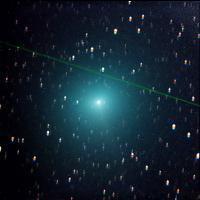 |
| ©Unknown |
| Comet Boattini |
On November 20, 2007 the comet was spotted by Andrea Boattini during
the course of the Mt. Lemmon survey in Arizona. Italian Boattini's
interest is in near-Earth asteroids and he during his research has
discovered and co-discovered no less than 170 mostly main-belt
asteroids.
Since that time, Andrea has become involved with the Catalina and Mt. Lemmon program and has made several additional asteroid discoveries. Of these, object 2007 WD5,
made headlines during its extremely close approach to Mars at the end
of January 2008. Comet C/2007 W1 is Andrea Boattini's first comet
discovery and we hope not the last!
NASA Finds New Type of Comet Dust Mineral
William P. Jeffs
nasa.gov
Thu, 12 Jun 2008 20:37 EDT
HOUSTON -- NASA researchers and scientists from the United States,
Germany and Japan have found a new mineral in material that likely came
from a comet.
The mineral, a manganese silicide named Brownleeite, was discovered
within an interplanetary dust particle, or IDP, that appears to have
originated from comet 26P/Grigg-Skjellerup. The comet originally was
discovered in 1902 and reappears every 5 years. The team that made the
discovery is headed by Keiko Nakamura-Messenger, a space scientist at
NASA's Johnson Space Center in Houston.
"When I saw this mineral for the first time, I immediately knew this
was something no one had seen before," said Nakamura-Messenger. "But it
took several more months to obtain conclusive data because these
mineral grains were only 1/10,000 of an inch in size."
A new method of collecting IDPs was suggested by Scott Messenger,
another Johnson space scientist. He predicted comet
26P/Grigg-Skjellerup was a source of dust grains that could be captured
in Earth's stratosphere at a specific time of the year.
In response to his prediction, NASA performed stratospheric dust
collections, using an ER-2 high-altitude aircraft flown from NASA's
Dryden Flight Research Center at Edwards Air Force Base, Calif. The
aircraft collected IDPs from this particular comet stream in April
2003. The new mineral was found in one of the particles. To determine
the mineral's origin and examine other dust materials, a powerful new
transmission electron microscope was installed in 2005 at Johnson.
"Because of their exceedingly tiny size, we had to use
state-of-the-art nano-analysis techniques in the microscope to measure
the chemical composition and crystal structure of Keiko's new mineral,"
said Lindsay Keller, Johnson space scientist and a co-discoverer of the
new mineral. "This is a highly unusual material that has not been
predicted either to be a cometary component or to have formed by
condensation in the solar nebula."
Since 1982, NASA routinely has collected cosmic and interplanetary
dust with high-altitude research aircraft. However, the sources of most
dust particles have been difficult to pin down because of their complex
histories in space. The Earth accretes about 40,000 tons of dust
particles from space each year, originating mostly from disintegrating
comets and asteroid collisions. This dust is a subject of intense
interest because it is made of the original building blocks of the
solar system, planets, and our bodies.
The mineral was surrounded by multiple layers of other minerals that
also have been reported only in extraterrestrial rocks. There have been
4,324 minerals identified by the International Mineralogical
Association, or IMA. This find adds one more mineral to that list.
The IMA-approved new mineral, Brownleeite, is named after Donald E.
Brownlee, professor of astronomy at the University of Washington,
Seattle. Brownlee founded the field of IDP research. The understanding
of the early solar system established from IDP studies would not exist
without his efforts. Brownlee also is the principal investigator of
NASA's Stardust mission.
The comet researchers include Messenger; John Jones, a co-discoverer
of the mineral from Johnson; Simon Clemett and Michael Zolensky in
Johnson's Astromaterials Research and Exploration Science Directorate;
Russ Palma, Minnesota State University at Mankato; Robert Pepin,
University of Minnesota, Minneapolis; Wolfgang Klöck, Röntgenanalytik
Messtechnik GmbH, Germany; and Hirokazu Tatsuoka, Shizuoka University,
Japan.
For additional information on NASA programs, visit NASA.
Scientists confirm that parts of earliest genetic material may have come from the stars
Imperial College London
Fri, 13 Jun 2008 09:29 EDT
Scientists have confirmed for the first time that an important
component of early genetic material which has been found in meteorite
fragments is extraterrestrial in origin, in a paper published on 15
June 2008.
The finding suggests that parts of the raw materials to make the first molecules of DNA and RNA may have come from the stars.
The scientists, from Europe and the USA, say that their research, published in the journal Earth and Planetary Science Letters, provides evidence that life's raw materials came from sources beyond the Earth.
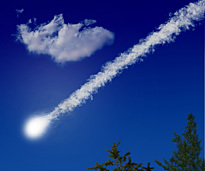 |
| ©Unknown |
| Genetic material from space rock |
The materials they have found include the molecules uracil and
xanthine, which are precursors to the molecules that make up DNA and
RNA, and are known as nucleobases.
The team discovered the molecules in rock fragments of the Murchison meteorite, which crashed in Australia in 1969.
They tested the meteorite material to determine whether the
molecules came from the solar system or were a result of contamination
when the meteorite landed on Earth.
The analysis shows that the nucleobases contain a heavy form of
carbon which could only have been formed in space. Materials formed on
Earth consist of a lighter variety of carbon.
Lead author Dr Zita Martins, of the Department of Earth Science and
Engineering at Imperial College London, says that the research may
provide another piece of evidence explaining the evolution of early
life. She says:
"We believe early life may have adopted nucleobases from meteoritic
fragments for use in genetic coding which enabled them to pass on their
successful features to subsequent generations."
Between 3.8 to 4.5 billion years ago large numbers of rocks similar
to the Murchison meteorite rained down on Earth at the time when
primitive life was forming. The heavy bombardment would have dropped
large amounts of meteorite material to the surface on planets like
Earth and Mars.
Co-author Professor Mark Sephton, also of Imperial's Department of
Earth Science and Engineering, believes this research is an important
step in understanding how early life might have evolved. He added:
"Because meteorites represent left over materials from the formation
of the solar system, the key components for life -- including
nucleobases -- could be widespread in the cosmos. As more and more of
life's raw materials are discovered in objects from space, the
possibility of life springing forth wherever the right chemistry is
present becomes more likely."
UK: Man claims a meteorite left a hole in his garden
Simon Albert
Winsford Guardian
Sat, 14 Jun 2008 11:21 EDT
A Winsford man had an unwelcome visitor on Sunday night in the form of a small meteorite.
Graham Brooks, 37, a heavy goods vehicle fitter, lives at his mother Christine's house at Railway Cottages in Rilshaw Lane.
He was sitting at home looking at wedding magazines with his partner Karen at around 10.30pm when he heard a loud bang outside.
When the couple went to see what had happened, they found a pile of
stones and soil up against their caravan in the back garden and a small
golf-ball sized hole in the ground leaving bits of silver fragments
around it.
Graham said: "It felt like a gas cylinder exploded or something and there was a very loud bang."
The incident was believed to have been caused by a small meteorite
hitting the ground that caused soil and stones to make dents in the
caravan.
Graham added: "I've never seen or heard anything like it before.
"If it had been three feet closer then it would have come through the skylight in the roof and hit us.
"It was as loud as a gunshot and the neighbours were gobsmacked.
"I was very shocked by the incident and we're supposed to be getting married in September as well."
Graham spoke to Terry O' Brian, who works for Manchester Museum, who
asked Graham to post the bits to him for analysis but believes it might
have been a meteorite from Graham's description.
It is estimated to have caused around £1,000 worth of damage to the caravan.
Graham and his partner Karen are currently speaking with their insurance company to see if they are covered.
Fremont, California Fireball/Meteor Sighting
United States UFO Blog
Mon, 16 Jun 2008 21:31 EDT
Date: June 14, 2008
Time: Approx: 11:55 p.m.
Location of Sighting: Fremont, CA.
Number of witnesses: 2
Number of objects: 1
Shape of objects: Fireball.
Full Description of event/sighting: My wife and I, traveling south
through Fremont, CA, around 11:55 pm, saw what looked like an extremely
bright meteor descending toward the southern horizon. We cannot say
that it was a UFO, but it was astonishingly bright and we at first
thought a plane or some other object might be falling toward the local
town of Milpitas. Only later, based on similar reports on Yahoo, did we
conclude that it might be a meteor heading due south. However, it was
much brighter than any meteor I have ever seen before. We note with
interest: a) several reports of sightings in southern California that
report the object moving north (rather than south, as in most
accounts); b) there were similar sightings in Seattle and Portland; c)
the coincident UFO sightings.
Thank you to the witness for their report.
Brian Vike, Director HBCC UFO Research and host of the Vike Report UFO Eyewitness radio show. email: hbccufo@telus.net
Radio show host for the Vike Report, eyewitness relating their experiences.
Just added, the Vike Report Radio Show Blog. You can check the blog out for archived radio shows and all the new and upcoming programs I do.
HBCC UFO Research, Box 1091 Houston, British Columbia, Canada - VOJ 1ZO
Russia's space agency backs U.S. asteroid control plan
RIA Novosti
Thu, 19 Jun 2008 17:02 EDT
Russia's Federal Space Agency has endorsed a proposal by the U.S.
House of Representatives that a Russian radar station be used to detect
dangerous asteroids, Roscosmos head said on Thursday.
"I generally approve and support the U.S. initiative," Anatoly Perminov said in a telephone interview with RIA Novosti. "As for the asteroid danger, it really exists, and needs to be dealt with through the joint efforts of all states concerned."
Comment: And yet, the danger is grossly underestimated, or intentionally downplayed . There are more than enough facts that something wicked this way comes, and those are not just lurking asteroids.
On Wednesday, the U.S. House of Representatives approved NASA's
$20.2 billion budget for 2009, committing the U.S. to cooperation with
Russia and other countries to avoid asteroid threats.
Congressmen suggested a Russian telecommunication center in the
Primorye Territory, in the Far East, could be used for early warning
and detection of dangerous asteroids.
Perminov said the RT 70 radar deployed in the town of Galenki near
Ussuriisk (the second largest city in Primorye) is a facility used by
Russia's Space Forces.
"This matter is more a question for the Defense Ministry, but we will back the project as an idea," he said.
J. Borovicka et al
IRF
Mon, 06 Aug 2001 08:04 EDT
Session 8: "Fireballs, Bolides and Meteorites"
The Moravka Meteorite Fall: Fireball Trajectory, Orbit and Fragmentation
J. Borovicka, P. Spurny and Z. Ceplecha (Astronomical Institute, Academy of Sciences, 251 65 Ondrejov, Czech Republic)
The Moravka meteorite fall of May 6, 2000, is only the sixth case in
history, when the pre-fall trajectory could be determined from
instrumental records. A very bright fireball appeared during broad
daylight at 11:51:52 UT and was seen by thousands of people.
Fortunately, three casual witnesses captured the fireball on video. The
fireball was also detected by satellite-based infrared and visible
sensors. Sonic booms were recorded by a local seismic network and an
infrasound array located in Germany recorded signals from this event.
Three ordinary chondrites of type H5-6 and total mass of 634 g were
recovered in the vicinity of village Moravka, Czech Republic (18.53E,
49.60N) over a span of 11 km. Much more fragments certainly fell, since
one video record shows multiple hierarchical fragmentation to more than
hundred pieces. After a careful calibration of the videos, we were able
to determine the fireball trajectory with a good precision. The initial
velocity was 22.5 km/s and the trajectory slope 20 degrees to
horizontal. The most resistant fragment disappeared at an altitude of
21 km when decelerated to 4 km/s. The heliocentric orbit is notable by
a high inclination of 32 degrees. Details of fireball dynamics and
fragmentation will also be given. 8.1
On the Relationship between Asteroids, Fireballs and Meteorites
A.E. Rosaev (FGUP NPC NEDRA, Yaroslavl, Russia)
Best of interest searching for parental bodies for meteors,
fireballs and meteorites with well determined orbits. We use two days
to study this problem in this work. First way - in-vestigation close
orbits by one of number of empirical criterion's like criterion
Southworth -Hawkins. The second way is to study the orbits
intersections statistics. The fireballs of Prai-rie network and
meteorites with well determined orbits was took into account.
Obviously, that fireballs and meteorites - an essence of bodies, having
potentially unstable orbits and, as an effect, small time life's. If
take sufficiently natural suggestion on that, that similar objects are
form in collisions NEA with each other and with comets, possible expect
that crossing the orbits of asteroids and fireballs, or meteorites will
indicate us on the most close on a time events of mutual collisions
NEA. Really, the distribution nearly intersected orbits in the system
NEA-fireball and fireball-fireball show significant non-homogenous.
Possible select about 10 areas to concentrations the cross points of
orbits of fireballs and NEA. Probably, they correspond to the most
recent disastrous events. Results of calculations for meteorites Lost
City, Prhibram, Innisfree Peekskill and Tun-guska's is given. In case
of a general conclusion of this work, the hypothesis of an very close
relation stud-ied meteorites with NEA put forward. 8.2
Relation of Meteoroid Ablation-Classification to Light Curves
D.O. ReVelle (1) and Z. Ceplecha (2)
1) Los Alamos National Laboratory, P.O. Box 1663, MS J577, Earth
and Environmental Sciences Division, EES-8, Atmospheric and Climate
Sciences Group, Los Alamos, NM 87545, USA; 2) Emeritus: Academy of
Sciences, Astronomical Institute, Observatory, 25165 Ondrejov, Czech
Republic
Classification of bolides according to their ablation coefficients
allows the recognition of 4 different groups: type I, type II, type
IIIA, and type IIIB. (In addition, iron bolides have also been
identified by the authors, but from our limited data set, we can not
evaluate them using the current effort). The possibility of determining
to what type a bolide belongs from just light curve data was examined,
and a criterion IT = (1/I)(dI/dt) was earlier proposed. The statistical
significance of sorting bolides according to IT was also established.
Recently, we have revised our original light-curve classification using
ground-based radiometer data taken at the Ondrejov Observatory provided
by Sandia National Laboratory (courtesy of Mr. Richard Spalding,
operated by Mr. Pavel Spurny) and have determined: a) the originally
proposed classification tables published in the Annals of the New York
Academy of Sciences (1997) are valid and form the best possibility
available at the moment, but they should be utilized only if light
curves are the only form of observational data available, b) relevant
results can be obtained for values of brightness separated by a time
interval, dt, of 0.05 s (if a shorter interval is available, one should
adjust the interval by summing all data inside each 0.05-s interval),
c) associating a bolide with a single type by using only light-curve
data is rarely possible, since only the probability of belonging to one
of the 4 types can be determined, d) the ablation coefficient, sigma
and the shape-density coefficient, K, cannot be construed as a weighted
average and must be taken for each bolide type separately, e) if other
precise observational data can be derived (e.g. data on heights and
velocities at several points), they are certainly preferable for
determining the sigma and K values. The characteristic light curve
determined for each of these4 meteoroid types will be presented. PSB-10
Bolide Fragmentation Theory with Application to PN and EN fireballs
D.O. ReVelle (1) and Z. Ceplecha (2)
1) Los Alamos National Laboratory, P.O. Box 1663, MS J577, Earth
and Environmental Sciences Division, EES-8, Atmospheric and Climate
Sciences Group, Los Alamos, NM 87545, USA; 2) Emeritus: Academy of
Sciences, Astronomical Institute, Observatory, 25165 Ondrejov, Czech
Republic
The simple physical concept of the conservation of energy and
momentum (single-body theory) was applied to a majority of
multi-station photographic observations of bolides assuming that the
entry behavior could be successfully described using a constant value
of the ablation coefficient (sigma), the shape-density coefficient (K),
and allowing for a single sudden gross-fragmentation at one distinct
altitude. If the precision of the observational data is better than
+/-30 m in distance measured along the bolide trajectory, then about
40% of the events can be explained without any gross-fragmentation,
about 40% are explainable with one gross-fragmention point and about
20% have definitely experienced more than one gross-fragmentation
point. High values of the derived ablation coefficients from
observations speak for nearly continuous fragmentation as being the
main mass-loss process for these bodies. If the precision of the
observational data is better than +/-15 m as described above, then the
assumption of constant sigma and K is no more sustainable. There are
not many data available with such a high precision. The complete
solution of the problem with sigma and K being functions of time was
subsequently derived and applied to 22 PN and EN fireballs each with
the needed high precision. The luminous efficiencies, tau, can also be
determined from this approach as well. We will present our results on
sigma, K, and tau as a function of the many different variables and
parameters of the problem for individual bolides during their luminous
trajectory and for individual bolide types. PSB-11
Infrasonic Monitoring of the Global Influx Rate of Large Bolides
Douglas O. ReVelle (Los Alamos National Laboratory, Los Alamos, NM 87545, USA)
We have utilized recent infrasonic bolide observations to estimate
the large bolide influx rate. These infrasonic signals are from the
densest, most deeply penetrating objects entering the atmosphere.
Undoubtedly, depending on the exact mass range under consideration, the
total influx is about a factor of five-ten times greater. This work is
a continuation or work shown at the Cornell ACM meeting in 1999 and
initiated by Wetherill and ReVelle in the late 1970's using data from
AFTAC (Air Force Technical Applications Center, Patrick AFB, Florida).
There have been several additional large bolides detected
infrasonically since 1999 that are included in our latest evaluation of
the global influx rate of large bolides. Some of these have also been
detected independently by US DoD Satellites. Thus, in some cases we
also have independent estimates of the bolide source energy that can be
used for an evaluation of the accuracy of the infrasonic source energy
estimate. We have also used statistical counting error procedures to
estimate the uncertainty in the influx rate as a function of the source
energy, assuming that the source energy estimates are without error.
For example, at a source energy of 0.2 kt (1 kt = 4.185X10(12) joules),
we find a global influx rate and its estimated uncertainty of 28.1
(+/-8.9) bolides per year. 8.3
Bolide Fragmentation Processes: Comparisons of Bolide Data against Theoretical Bolide Models
Zdenek Ceplecha (Astronomical Institute, Czech Academy of
Sciences, Ondrejov Observatory, Ondrejov, The Czech Republic) and
Douglas O. ReVelle (Los Alamos National Laboratory, Los Alamos, NM
87545, USA)
This work is a practical extension and testing of theoretical work also submitted to the Meteoroids2001 conference.
We have applied the fragmentation model of ReVelle to the most precise
EN and PN fireballs in order to evaluate the shape change parameter,
and the fragmentation scale height in comparison to the pressure or
density scale heights. If the ratio of the fragmentation scale height
to the density scale height is large, we recover the single-body model
limit. In the opposite extreme, pancake type fragmentation is possible.
This was done in order to determine if, for any of the available very
precise bolide observations, a parameter range existed that allowed
pancake type catastrophic fragmentation processes to occur. This is
important since a number of workers in the early 1990's identified this
behavior as being important for the larger bodies entering the
atmosphere in the small ablation limit (Hills and Goda, Chyba, Zahnle
and Thomas, etc.). We are currently examining a number of bolides with
very precise observations to determine these fundamental properties and
will report on our findings at the conference. 8.4
Bolide Fragmentation Modeling
Douglas O. ReVelle (Los Alamos National Laboratory, Los Alamos, NM 87545, USA)
In this talk we extend work begun at the Cornell ACM meeting. The
shape change parameter is evaluated for conditions when it is negative.
For the values of the shape change parameter between 0 and 2/3,
ablation, shape change and deceleration can occur. For values < 0,
however, large lateral growth of the body occurs. This negative region
of the shape change parameter corresponds to the flight regime that was
"rediscovered" by Hills and Goda and by Chyba, Zahnle and Thomas in the
1990's and analyzed in detail by Grigoryan in the 1970's. We have
determined analytic expressions for the shape change parameter
(assuming a constant ablation parameter and constant meteoroid
velocity) and for the fragmentation scale height, Hf. We have evaluated
Hf assuming that fragmentation was triggered if the stagnation pressure
exceeded the body's compressive/tensile strength. If Hf >> H, the
density scale height, the single-body approximation is applicable,
whereas, if Hf << H, catastrophic, pancake break-up will occur.
In the limit with the shape change parameter < 0 with very small
ablation, large increases in the frontal cross-sectional area are
predicted to occur, but only over a very limited range of conditions.
In addition, as the shape change parameter becomes progressively more
negative, end heights raise substantially. We also evaluate the effect
of a negative shape change parameter on light emission so that a nearly
complete, self-consistent model of the bolide phenomena can be
formulated. PSB-12
Bolide Luminosity Modeling: Comparisons between Uniform Bulk Density and Porous Meteoroid Models
Douglas O. ReVelle (Los Alamos National Laboratory, Los Alamos, NM 87545, USA)
We compare predictions of normalized bolide luminosity for two
fundamental bolide models, one assuming a uniform bulk density
throughout the body and a second which assumes a uniform chondritic
composition throughout, but with varying amounts of porosity (assumed
to be filled with either water-ice or open space). The second model is
based upon the uniformity of spectral observations taken over many
years during periods of shower meteors from the extremes of the
Geminids to the dustball-like Draconids. The first model utilized is
due to ReVelle (1979, 1993) and the second is based upon the porous
meteoroid model of ReVelle (1983, 1993). The standard, uniform bulk
density, ablation model assumes that the drag and heat transfer area
are equivalent in the positive, shape change factor limit. For porous
meteoroids however, the heat transfer area can exceed the drag area by
increasingly larger amounts as the body's porosity increases. ReVelle
(1983) used this approach to show that the bulk density and ablation
parameter compositional group identifications of Ceplecha and McCrosky
(1976) were essentially correct. When these factors are introduced into
the relevant model equations, a set of nearly self-consistent
predictive relations are developed which readily allows comparisons to
be made of the end-height variations and of the normalized luminous
output of the two basic types of meteoroid models. PSB-13
On Electrophonic Phenomena
A.Yu. Ol'khovatov (Radio Instrument Industry Research Institute, Moscow, Russia)
During last years an idea that electrophonic sounds are caused by
VLF electromagnetic radiation from a bolide's wake is promoted again.
The source of the radiation is considered to be "magnetic spagetti
relaxation" in a bolide's wake. The most serious problem with the
theory is that level of detected VLF disturbances, accompanied a bolide
is negligibly small, comparing with needed for hearing VLF radiation.
For example, C. Keay experiments revealed lower limit of hearing in
order of 160 V/m. It means that a bolide producing electrophonic sounds
is to generate in its wake VLF radiation with the power at least in
order of 10^12 W. Nor present theory neither experiments with turbulent
ionized wakes predicts such superpowerful VLF radiation. Anyway, if it
is realized somehow, it would lead to spectacular effects, for example,
to enormous Joule heating of the wake (due to extremely large electric
currents) transforming the wake into object as bright (seen from the
ground) as at least the Sun. And, of course, this "super-radiation"
would produce remarkable global effects - but none of them are known.
The presence of "transducers" near an observer can't help the
situation, as the needed level to hear their vibrations are even in
order of magnitude larger, and anyway, it can't be lowered down many
orders of magnitude. A solid confirmation that these estimations are
correct is the fact that otherwise people would hear numerours VLF
transmitters hundreds miles away! Also there were reports of
electrophonic sounds during several Space Shuttle re-entries. The the
hypothetical "super-radiation" (if exists) would produce a very
remarkable (devastating) effect on the spaceplane. Also, in many
electrophonic events the power of aerobraking, i.e. the power deposited
by a meteoroid into the atmosphere, which is to be the energy source of
the proposed VLF super-radiation was much less that the power of the
latter. 8.5
Recent Infrasonic Observations of Large Bolides
Peter Brown (Los Alamos National Laboratory, Los Alamos, New
Mexico, USA, and Department of Physics and Astronomy University of
Western Ontario London, Ontario, Canada), Douglas O. ReVelle and Rod
Whittaker (Los Alamos National Laboratory, Los Alamos, New Mexico, USA)
We expect a minimum of several dozen bolides to impact the Earth
each year and penetrate low enough in the atmosphere to produce
infrasonic waves. These objects have energies from 10-2 kT to many
hundreds of kT and many of these are also simultaneously observed by US
DoD satellites. Here we present a summary and discussion of more than
15 infrasonically observed bolide events detected since 1996. These
data demonstrate the capability of infrasound arrays to reliably locate
the source of bolide explosions in the atmosphere at heights of
typically 20-30 km and at ranges exceeding 5000km. We find, for
example, that a 0.2kT bolide detonation can be detected at ranges of
3300 km under good conditions. Most notable among these recent events
is a multi-kt event recorded off the coast of Mexico on 25 Aug, 2000
which was recorded by six infrasound stations and a large (~20 kt)
detonation in the South Pacific on 18 Feb, 2000. The modelling and
interpretation of some individual events and comparison with other
instrumental records of the same bolides will be highlighted. PSB-14
The Tagish Lake Meteorite Fall : Interpretation of Physical and Orbital Data
Peter Brown (Los Alamos National Laboratory, Los Alamos, New
Mexico, USA, and Department of Physics and Astronomy, University of
Western Ontario, London, Ontario, Canada), Douglas O. ReVelle (Los
Alamos National Laboratory, Los Alamos, New Mexico, USA) and Alan
Hildebrand (Department of Geology and Geophysics, University of Calgary)
The Tagish lake meteorite fell 18 Jan, 2000 at 16:43 UT in Northern
British Columbia Canada. Some 500 meteorites were later found on the
frozen ice-surface of Tagish Lake. The fireball accompanying the
meteorite fall was widely recorded by ground-based
photographers/videographers, earth-orbiting satellites, seismic and
infrasound sensors. The associated meteorites have proven unique;
reflectance spectra from Tagish Lake is the first to match that of
D-class asteroids (Hiroi et al., 2001) and the bulk density of TL is
the lowest measured for any meteorite at 1.67 g cm-3 (Zolensky, pers
comm). Here we will discuss the data relating to the fireball and
associated modelling to determine the orbit of TL and probable physical
structure. Most notably, the fireball data suggest that TL is
intermediate between Type II and III fireballs. Our modelling indicates
the initial body had a porosity near 50%. Type III objects are presumed
to be related to cometary bodies and suggests that TL and by extension
D-asteroids might be intermediate in physical structure between
primitive chondritic asteroids and cometary nuclei. 8.6
Common Ground-based Optical and Radiometric Detections of Fireballs within the Czech Part of the European Fireball Network
Pavel Spurny (Astronomical Institute, Academy of Science,
Ondrejov Observatory 251 65 Ondrejov, The Czech Republic) and Richard
E. Spalding (Sandia National Laboratories, PO Box 5800, Albuquerque, NM
87185-0978, USA)
Since August 1999 two radiometric systems equiped with optical
sensors are operated at two stations of the Czech part of the European
fireball network (EN). During this period we have obtained several very
detailed lightcurves for bright fireballs recorded also
photographically in scope of the EN. First results of this study will
be presented. PSB-15
The EN310800 Vimperk Fireball: Probable Meteorite Fall of an Athen-type Orbit Meteoroid
Pavel Spurny and Jiri Borovicka (Astronomical Institute, Academy
of Science, Ondrejov Observatory 251 65 Ondrejov, The Czech Republic)
We report a detection of an unique fireball photographed at two
Czech stations of the European Fireball Network. This slow-moving
fireball with initial velocity of only 15 km/s reached the maximum
absolute brightness -14 and penetrated down to almost 20 km. The
meteorite fall of several pieces of the total mass of several kilograms
is highly probable. However, no meteorite has been recovered yet. From
one very rough spectral record and also from its behavior in the
atmosphere we found that it was stony meteoroid, probably ordinary
chondrite. The main exceptionality of this fireball is in its
heliocentric orbit, with semimajor axis only 0.8 AU, eccentricity 0.3,
aphelion 1.03 AU and inclination 17 degrees. This rare Aten type orbit
is only third one in the history of decades-long operation of the
European Fireball Network. PSB-16.
Global Infrasonic Monitoring of Large Meteoroids
Douglas O. ReVelle
The Acoustical Society of America
Sun, 01 Jul 2001 08:08 EDT
Networks of low-frequency acoustic detectors, originally built for
other purposes, are now finding a new and unexpected use in detecting
objects that enter our atmosphere. The orbit of Earth through the solar
system passes through much solid particle debris, including pieces of
material from both comets and asteroids. We call these arriving
particles "meteoroids." The asteroidal and cometary sources have a wide
variety of properties, so meteoroids can arrive from very different
orbits and belong to one of several types of observed materials. They
can be iron, rocky stones, very weak stones (Carbonaceous chondrites)
or there are two brands of very weak cometary material as well. This
debris can be either very small or very large or have a large range of
possible sizes, depending on the source and how long the material has
been orbiting in space free from its source and other factors. This
material can also have a large range of possible entry speeds and
densities.
As Earth moves about the Sun, it acts as a tiny dust mop sweeping up
this material which can strongly interact with the atmosphere at very
great heights (above 60 miles). On occasion these larger and brighter
meteors and fireballs or bolides (the name of the atmospheric
phenomena) travel at high speeds to collide with Earth's surface and
possibly even produce an extensive crater. This delivery of meteorite
samples (the ponderable pieces that reach the Earth intact),
originating on other worlds beyond our own, provides a means of
studying our own origins as well.
The interaction of these meteoroids with the atmosphere is very
strong partly due to the very high speed at entry and partly due to the
compressibility of the atmosphere. The entry speed compared to the
speed at which sound waves travel, called the Mach number, typically
can range from 50 - 300. For comparison, a typical Mach number of a
commercial or military supersonic jet is less than 3. As a direct
consequence of this high speed, an explosion is generated along a
cylindrical path about the entry trajectory. This deposition of energy
along the path constitutes an explosion whose characteristic scale is
called the "blast wave radius", which delineates the size of the region
in which an explosion has occurred. For large meteoroids capable of
penetrating the atmosphere down to heights
where a shock wave is formed, this scale can range from a minimum
of 10 meters (in order to be recorded at ground level) to many
kilometers in length. For comparison, the typical size scale of the
sound source in ordinary thunder is about 2 or 3 m.
Sounds that emanate from such sources in the atmosphere can have
very large amplitudes, even great enough to break glass windows at
close range. Frequencies of such sources can be low enough so that the
peak energy is below the range of audible sound waves, which we call
"infrasound." As the
blast wave radius increases we find that these frequencies become
progressively lower. For the famous Siberian meteorite explosion
(Tunguska) of 1908, ultra-low sound frequencies of 1/60 Hertz
(corresponding to a period of about 1 minute) were observed at great
distances from the entry trajectory. As these signals propagate through
the atmosphere, the ambient
temperature and winds aloft can bend the signals away from
straight-line paths, i.e., refraction. They can also be diffracted and
scattered as well since this is a wave phenomenon. We now know
empirically how to relate the period at maximum amplitude of the sound
waves to the source energy. For the blast wave radius values quoted
above, source energies range from 0.00001 kt (1/100 of a ton of TNT) to
10 Mt (megaton) of TNT equivalent (1 kt = 4.186×1012 Joules). For comparison, the nuclear weapons dropped in Japan in WWII produced explosions of about 15 kt.
Over the past few years we have observed a number of these very
large bolides over a very large energy range. From these data we have
been able to locate the sources and calculate the frequency of
occurrence of these large bodies at the Earth in a year. The
observations at arrays of sensors on the ground using low frequency
microphones, separated horizontally by distances of a few hundred
meters to a few km typically, can be used to determine both the angular
great circle distance of the arrival as well as the elevation angle of
the signals. This allows us to uniquely locate these sources in
three-dimensional space within the atmosphere within certain errors.
For example at a range of 3350 km, a bolide of about 0.2 kt was readily
recorded infrasonically even as long ago as 1965. Also, from such data
we can estimate that the frequency of occurrence of rocky type
meteoroids for a energy of 15 kt is about once per year over the globe.
At the energy of Tunguska (10 Mt), it is about once every 120 years and
this event last occurred about 93 years ago. Corresponding to an energy
of
0.1 kt for example, we find a value and associated uncertainty of
about 30 ± 9 large bolides/year and this value continues to increase as
the source energy decreases and vice versa.
Douglas ReVelle is at the Los Alamos National Laboratory. This
paper is based on the lay-language version of paper 2pPAa4 at the 141st
ASA Meeting, Chicago, IL
Flashback:
Philippines: Authorities probing 'mysterious' Tagum blast
Frinston Lim
Mindanao Bureau
Wed, 28 May 2008 13:44 EDT
Police and military authorities here remain clueless on what caused
the huge explosion that occurred near a military camp and two
provincial jail complexes in a village here Tuesday night.
Investigators are still determining whether the blast was caused by
an explosive device or a grenade since there was no trace of bomb or
grenade fragments in the vicinity where the explosion was heard, said
Senior Superintendent Benilito Bianzon, Davao del Norte police director.
The explosion, Bianzon said, was heard at around 10:45 p.m. amid a
heavy downpour in the vicinity of the Davao del Norte provincial
rehabilitation center (DPRC) gate and the bunkhouses of the Division
Recon Company of the 1003rd Infantry (Raptor) Brigade in the village of
Mankilam.
"Our EOD (explosives and ordnance disposal) team went there to
investigate but they have yet to locate the exact site of the explosion
which probably may be manifested by a small crater in the ground,"
Bianzon told reporters on Wednesday.
The military also said it could not yet determine what really
exploded as they were relying also on the findings of the police EOD.
Flashback:
Bangladesh: Mysterious booms rock city
The Daily Star
Wed, 11 Jun 2008 13:39 EDT
Panic gripped city dwellers in the early hours yesterday when sounds of several explosions rocked parts of the capital city.
Neither police nor the Inter-Services Public Relations (ISPR) could
say anything with certainty about the explosions or from where the
sound of explosions originated.
Some city dwellers heard six to seven loud explosion sounds in southern parts of Dhaka at around 12:40am yesterday.
A number of businessmen at Tejgaon said they heard the sounds around
the same time, seeming to come from different parts of the city.
Some others living in the Dhaka University area also confirmed hearing similar sounds, also around the same time.
When contacted, police from different police stations said they also
heard the explosion-like sounds but could not ascertain where it came
from.
ISPR officials said they have no information regarding the matter.
Massachusetts, US: Mysterious odor descends on Cape Cod
Cape Cod Times
Thu, 12 Jun 2008 14:07 EDT
Cape Codders by the hundreds were asking themselves and their fire departments Tuesday night, "What's that funny smell?"
An odor variously described as burning rubber, burning electrical
outlets, burning car brakes and melting plastic was reported to fire
departments from Eastham to Bourne.
Firefighters in full turn-out gear from department after department
searched their towns with no luck. That is until around midnight, when
a radio broadcast from the Barnstable County Sheriff's Department came
up with a possible answer: temperature inversion.
Simply put, a temperature inversion can occur when an oncoming cold
front pushes a warmer air mass in front of it, then sits on top of the
warmer air mass, said Alan Dunham, a National Weather Service
meteorologist in Taunton.
In this case, the temperature inversion brought the stink from
someplace else and dropped it on our doorsteps.Then that cold front sat
on the stink for a couple hours.
"The conditions were just right for that," Dunham said of the
Tuesday night weather event. "We had this hot humid air, pollution or
smoke particles from elsewhere just attach themselves to that and
linger here."
In the case of the acrid smell assaulting Cape sensibilities, the possible source has not been pinned down.
It could have been residue from North Carolina where, Sunday and
Monday, firefighters battled more than 300 brush fires that forced the
evacuation of homes and burned 9,000 acres.
Or it could be pollution from New York City.
"I can't say for certain that it was the fires in North Carolina or
anything else," Dunham said. "But it is possible. We had similar
reports from southern Rhode Island."
Inverted temperatures are not all that rare, Dunham said, but once
in a while they get noticed by the general population because there is
a smell associated with them.
"A number of years ago, there were big fires in Canada and that
brought smoke down through Vermont, Maine, New Hampshire and
Massachusetts because of inverted temperatures," he said.
On the Cape, calls to fire departments seemed to cluster about the
time the Celtics crashed and burned in Los Angeles - shortly before
midnight. In Sandwich, calls came from all areas of the town.
Eastham firefighters similarly searched their town and at one point,
called the Coast Guard wondering if there were a ship burning off the
coast.
Staff at the county communication center sent dozens of calls to
fire departments in a relatively short period of time. Then from the
dispatch center came relief to many departments - a probable
explanation for the smell.
"We can't take the credit. We're just the middle man," said Peter
Thomas, director of the county communication center which dispatches
fire calls for seven Cape departments. "We got a call from Bob Crocker.
He put it together - a temperature inversion."
A 26-year veteran of the state Department of Recreation and
Conservation, Crocker is a district forest fire patrolman at Shawme
Crowell State Forest. Much of his training as a wild land firefighter
focused on weather conditions. "Wind, rain, terrain, slope - all of
that factors into your firefighter training," he said.
He was getting ready to turn in for the night Tuesday when he heard
an explosion of calls on his home scanner sending departments out on
smoke investigations.
"I got on my computer, checked out the weather channel and saw a
cold front coming in from around New York," he said. "I just figured
out what it was before anyone else had a chance," he said. "I didn't
solve a mystery or a problem. I just passed a little information along."
Fireball photographed in South Dakota
Drew Sandholm
KSFY.com
Fri, 20 Jun 2008 17:43 EDT
KSFY has been contacted by several
individuals, who report seeing several unidentified objects in Sioux
Falls' western skies Thursday evening.
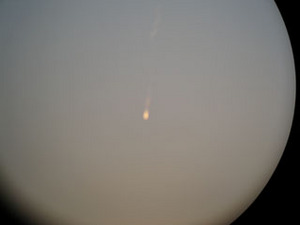 |
| ©Unknown |
| Thanks to Cari Jostad for this photo taken through binoculars. She's one of many reporting having saw this image in Sioux Falls' western sky Thursday evening. |
"Just like a fireball. I can't explain it any better than that,"
said Cari Jostad, who was outside with her two boys when they noticed
what she describes as a burning ball of fire. "You could see planes
flying by and you know they would come and go, but this just kept the
same line and kept going."
She quickly grabbed her camera and took photo after photo, which can
be viewed by clicking the link in this article. Cari wanted a closer
look to see what these things were.
"Looking through the binoculars it was... it looked like a fire ball,"
she said. Her husband Bob sent several photos to KSFY looking for
answers, so we contacted the National Weather Service (NWS).
NWS examined three of the photos and determined it could be
explained by a contrail. A contrail forms when a passing jet leaves
water vapor in the air. The vapor freezes and the sun does the rest.
"The angle of the sun was just right to give you a different
atmospheric phenomena that made it look like it was a comet or some
other sort of atmospheric phenomena," said NWS' Shawn Liebl. He said
that would make sense because the sun was setting at the time the
sightings were reported, but said he'd have to have video evidence to
know for sure.
For the Jostads and others who saw this phenomena, they'd like to
know exactly what it was. Then again, their boys think they have the
answer --- Transformers coming to save the world.
KSFY tried contacting NASA for more information, but they were unavailable after hours.
Comment: The
National Weather Service explains it away as nothing more than a
contrail, because of course the people in South Dakota had never seen
one of those before, dontcha know. It would be outlandish to think,
given all of the fireballs recently witnessed, that there would be yet
another sighting, wouldn't it? Too many of those and people might start
getting the idea that Something Wicked This Way Comes
Australia: Fishos catch sight of UFO
Daniel Bourcher
Northern Territory News
Wed, 25 Jun 2008 21:21 EDT
It could be the one that got away. Fisherman Simon Moyle, his son
Rein and mate Eddie Carroll saw a UFO shooting across NT skies.
The trio were fishing at Shady Camp, 220km east of Darwin, when they
spotted an object zip across the sky and burst into fire around 5.30pm
on Sunday.
The incident was also reported by Northern Territory News readers
enjoying the sunset over Darwin Harbour from the cliffs at Fannie Bay.
Mr Moyle, 36, of Driver, Palmerston, said the UFO was not a plane.
He thinks it may have been a meteor or piece of space junk.
"I thought something must have been re-entering the atmosphere,'' he said.
Rein, 10, a Year 5 Parap Primary student, said the incident surprised him.
"I saw something orange really high in the sky and it looked like it was on fire,'' he said.
"It plummeted a big distance in two seconds and then it disappeared in a flash -- the smoke stayed for about half an hour.''
Mr Carroll, 37, of Woodroffe, said he had no idea what it was.
"I looked up in the sky and thought it was a plane at first,'' he said.
"It looked like a falling star -- it was lit for two seconds and
then exploded. I think it was a meteor -- it was too high to be a
plane.''
Territory astronomy enthusiast Geoff Carr said the sighting was odd.
"I can't explain it,'' he said.
"The atmosphere is an ocean of gas -- all sorts of things could happen.''
Huge crater on Mars 'solves red planet's two-faced riddle'
The Daily Mail
Thu, 26 Jun 2008 10:21 EDT
A giant crater made by an asteroid or comet is the reason Mars is so lopsided, scientists said today.
The impact gouged out a hole 5,200 miles across and 6,500 miles
long, leaving a basin covering 40 per cent of the red planet,
researchers reported in the journal Nature.
The depression is the size of the combined areas of Asia, Europe and
Australia, which makes it by far the largest crater in the solar system.
In 1984 scientists proposed an impact had caused the two-faced
appearance of Mars with two strikingly different kinds of terrain in
its northern and southern hemispheres.
 |
| ©Reuters |
| An artist's impression of a huge asteroid impact that would explain Mars' lopsided shape |
This fell into disfavor because the 'Borealis Basin' didn't seem to fit the expected round shape
However, the latest three studies said some of the basin's edges have been erased by volcanic activity.
"We haven't proved the giant-impact hypothesis, but I think we've
shifted the tide," said Jeffrey Andrews-Hanna, a researcher at the
Massachusetts Institute of Technology (MIT).
It appears the crater held an ocean in the early days of the planet,
before Mars lost so much of its atmosphere and the water either
sublimated away or froze beneath the surface.
NASA's Phoenix Mars Lander last week scraped through the dry red
dust covering the planet's surface to reveal what appears to be white
ice underneath.
Mr Andrews-Hanna and MIT colleagues said the impact theory best explains the crater.
When the solar system was just maturing 4 billion years ago, big
objects often smashed into one another. The formation of the Earth's
Moon is attributed to a giant impact on the Earth.
In a second report, Margarita Marinova and colleagues at the
California Institute of Technology made three-dimensional simulations
of the impact.
'The impact would have to be big enough to blast the crust off half
of the planet, but not so big that it melts everything. We showed that
you really can form the dichotomy that way,' they said.
The shock waves from the impact would have traveled through the
planet and disrupted the crust on the other side, causing changes in
the magnetic field.
In a third report, Nimmo and colleagues said such magnetic anomalies have been measured in Mars' southern hemisphere.
Asteroid-hunting satellite a world first
University of Calgary
Thu, 26 Jun 2008 13:15 EDT
Canada is building the world's first space telescope designed to
detect and track asteroids as well as satellites. Called NEOSSat (Near
Earth Object Surveillance Satellite), this spacecraft will provide a
significant improvement in surveillance of asteroids that pose a
collision hazard with Earth and innovative technologies for tracking
satellites in orbit high above our planet.
Weighing in at a mere 65-kilograms, this dual-use $12-million
mission builds upon Canada's expertise in compact "microsatellite"
design. NEOSSat will be the size of a large suitcase, and is
cost-effective because of its small size and ability to "piggyback" on
the launch of other spacecraft. The mission is funded by Defence
Research Development Canada(DRDC) and the Canadian Space Agency(CSA).
Together CSA and DRDC formed a Joint Project Office to manage the
NEOSSat design, construction and launch phases. NEOSSat is expected to
be launched into space in 2010. The two projects that will use NEOSSat
are HEOSS (High Earth Orbit Space Surveillance) and the NESS (Near
Earth Space Surveillance) asteroid search program.
"Canada continues to innovate and demonstrate its technological
expertise by developing small satellites that can peer into near and
far space for natural and man-made debris," says Guy Bujold, President
of the Canadian Space Agency. "We are building the world's first
space-based telescope designed to search for near-Earth asteroids."
NEOSSat is the first follow up mission to the groundbreaking MOST
(Microvariability and Oscillation of STars) spacecraft, a 60-kilogram
satellite designed to measure the age of stars in our galaxy. NEOSSat
also marks the first project using Canada's Multi-Mission
Microsatellite Bus. CSA's Space Technology branch launched the
Multi-Mission Bus project to capitalize on technology developed for the
MOST project by making it adaptable to future satellite missions.
Captain Tony Morris of DRDC Ottawa, and Deputy Program Manager of
the NEOSSat Joint Project Office, says, "NEOSSat is a technological
pathfinder for us to demonstrate the potential of microsatellite
technologies to satisfy operational requirements of the Canadian
Forces. NEOSSat will demonstrate the ability of a microsatellite to
enhance the CF's contribution to the NORAD mission - providing accurate
knowledge of the traffic orbiting our planet. This would contribute to
the safety of critical Canadian assets, military and civilian, in an
increasingly congested space environment."
Dr. Brad Wallace leads the science team at DRDC for HEOSS, which
will use NEOSSat for traffic control of Earth's high orbit satellites.
Dr. Wallace says, "We have already done satellite tracking tests using
MOST, so we know that a microsatellite can track satellites. The
challenge now is to demonstrate that it can be done efficiently,
reliably, and to the standards required to maximize the safety of the
spacecraft that everyone uses daily, like weather and communication
satellites."
The HEOSS project will demonstrate how a microsatellite could
contribute to the Space Surveillance Network (SSN), a network of ground
based telescopes and radars located around the world. Until the 1980s,
Canada contributed to the SSN with two ground-based telescopes in
eastern and western Canada. The fact that HEOSS will be a space-based
capability on a microsatellite represents an exciting enhancement to
the contribution and offers significant advantages to the SSN.
Ground-based sensors' tracking opportunities are constrained by their
geographic location and the day-night cycle. In Sun-synchronous orbit
around our planet, NEOSSat will offer continuous tracking opportunities
and the ability to track satellites in a wide variety of orbit
locations.
"NEOSSat requires remarkable agility and pointing stability that has
never before been achieved by a microsatellite," says David Cooper,
General Manager of Mississauga-based Dynacon Inc., the prime contractor
for the NEOSSat spacecraft and the manufacturer and operator of the
MOST satellite. "It must rapidly spin to point at new locations
hundreds of times per day, each time screeching to a halt to hold rock
steady on a distant target, or precisely track a satellite along its
orbit, and image-on-the-run." Cooper says. "Dynacon is the world leader
in this microsatellite attitude-control-system technology."
Dr. Alan Hildebrand, holder of a Canada Research Chair in Planetary
Science in the University of Calgary's Department of Geoscience, leads
an international science team for the NESS asteroid search project and
is excited by its prospects.
"NEOSSat being on-orbit will give us terrific skies for observing
24-hours a day, guaranteed," Hildebrand says. "Keeping up with the
amount of data streaming back to us will be a challenge, but it will
provide us with an unprecedented view of space encompassing Earth's
orbit."
Although NEOSSat's 15-centimetre telescope is smaller than most
amateur astronomers', its location approximately 700 kilometres above
Earth's atmosphere will give it a huge advantage in searching the
blackness of space for faint signs of moving asteroids. Twisting and
turning hundreds of times each day, orbiting from pole to pole every 50
minutes, and generating power from the Sun, NEOSSat will send dozens of
images to the ground each time it passes over Canada. Due to the
ultra-low sky background provided by the vacuum of space, NEOSSat will
be able to detect asteroids delivering as few as 50 photons of light in
a 100-second exposure.
Hildebrand, who oversees the U of C's ground-based asteroid
observation program using the Rothney Astrophysical Observatory's
wide-field Baker Nunn telescope, said NEOSSat will greatly enhance the
study of asteroids and comets as they approach Earth. "NEOSSat will
discover many asteroids much faster than can be done from the ground
alone. Its most exciting result, however, will probably be discovering
new targets for exploration by both manned and unmanned space
missions," he observes. "By looking along Earth's orbit, NEOSSat will
find 'low and slow' asteroids before they pass by our planet and sprint
missions could be launched to explore them when they are in the
vicinity of the Earth."
Tunguska Event still a mystery 100 years on
RIA Novosti
Thu, 26 Jun 2008 12:40 EDT
Scientists will gather in Siberia to mark the 100th anniversary of
the Tunguska Event June 26-28, one of the world's most mysterious
explosions which flattened 80 million trees but largely went unnoticed
at the time.
The massive blast, equivalent to around 15 megatons of TNT, occurred
approximately 7-10 km (3-6 miles) above the Stony Tunguska River in a
remote area of central Siberia early on June 30, 1908. The explosion,
which was estimated to measure up to 5 on the Richter scale, knocked
people off their feet 70 km away and destroyed an area of around 2,150
sq km (830 sq miles).
And if the explosion had occurred some 4 hours and 47 minutes later,
due to the Earth's rotation it would have completely destroyed the then
Russian capital of St. Petersburg.
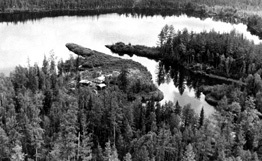 |
| ©Unknown |
However, despite the fact that the night sky was lit up across
Europe and Asia and the shock waves were detected as far away as
Britain, the Tunguska Event largely went unnoticed eclipsed by global
events leading up to World War I, the Russian Revolution and subsequent
civil war and it was not until almost 20 years later in 1927 that any
scientific expedition managed to visit the remote site.
The 1927-expedition led by Leonid Kulik, a leading meteorite expert
at the Academy of Sciences, discovered the massive destruction left by
the blast and gathered witness statements from locals living in the
area. It was assumed that a huge meteorite had hit the area, although
Kulik failed, during his research in Siberia, to find an obvious crater.
And around 33 years later another expedition was also unsuccessful
in its search for the elusive crater and scientists were faced with the
Tunguska mystery - an explosion, 1,000 times more powerful that the
WWII atomic bomb at Hiroshima, but which had left no trace as to its
cause.
Although there have been dozens of theories since, from UFOs,
antimatter, doomsday events and black holes, the most likely being an
airborne explosion of a 10-30-meter wide meteorite or comet, none of
them has provided conclusive evidence which has merely fuelled the
speculation surrounding Tunguska.
At the Tunguska conference in the Krasnoyarsk Territory in Siberia
scientists from all over Russia will gather to discuss, using the
latest computer technology, as well as less traditional methods, what
actually caused the destruction in the remote Siberian region.
As part of the anniversary, in the Evenki autonomous area, a statue
of the Evenki god of Thunder, which reflects eyewitness testimony to
the events 100 years ago, will be erected at the site believed to be
the meteorite crash location.
RIA Novosti
Thu, 26 Jun 2008 12:46 EDT
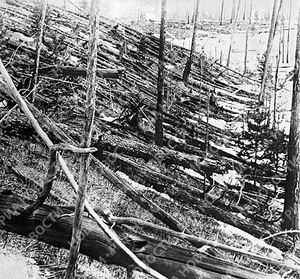 |
| ©RIA Novosti |
At 7.14 a.m. local time (12.14 a.m. Greenwich Mean Time), an
explosion occurred near the Podkamennaya (Lower Stony) Tunguska River
in East Siberia's Krasnoyarsk Territory, not far from the Vanavara
trading post, now Vanavara town, the administrative center of the
Evenki Autonomous Area's Tungussko-Chunsky District.
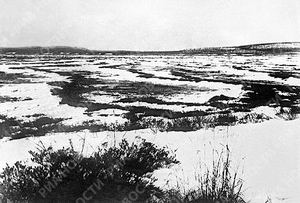 |
| ©RIA Novosti |
The meteorite could have killed millions of people if it had exploded over a densely populated area.
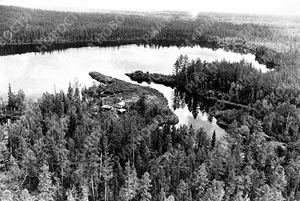 |
| ©RIA Novosti |
A place in the taiga near the Podkamennaya Tunguska River where the
Tunguska Meteorite fell on June 30, 1908. Scientists working in
different fields are still trying to solve the mystery of the Tunguska
explosion. An expedition studying the Tunguska event has a laboratory
here, on the shore of a taiga lake.
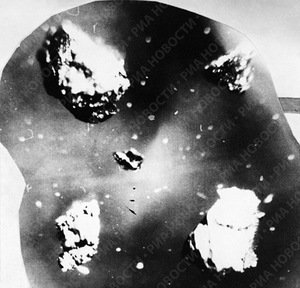 |
| ©RIA Novosti |
Diamond-graphite formations from the site of the Tunguska event on the Podkamennaya Tunguska River in the Krasnoyarsk Territory.
 |
| ©RIA Novosti |
Alexei Zolotov, a well-known authority on the Tunguska event and
department chief at the Oktyabrsky subsidiary of the All-Union
Geophysical Prospecting Methods Institute.
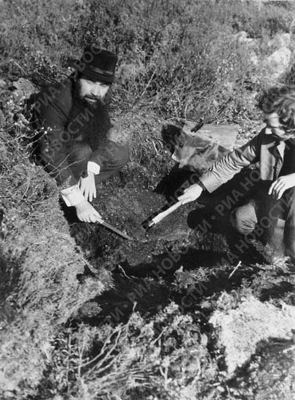 |
| ©RIA Novosti |
Soviet scientist Alexei Zolotov, left, scooping up earth samples in the vicinity of the Tunguska event.
Philippines: Authorities probing 'mysterious' Tagum blast
Frinston Lim
Mindanao Bureau
Wed, 28 May 2008 13:44 EDT
Police and military authorities here remain clueless on what caused
the huge explosion that occurred near a military camp and two
provincial jail complexes in a village here Tuesday night.
Investigators are still determining whether the blast was caused by
an explosive device or a grenade since there was no trace of bomb or
grenade fragments in the vicinity where the explosion was heard, said
Senior Superintendent Benilito Bianzon, Davao del Norte police director.
The explosion, Bianzon said, was heard at around 10:45 p.m. amid a
heavy downpour in the vicinity of the Davao del Norte provincial
rehabilitation center (DPRC) gate and the bunkhouses of the Division
Recon Company of the 1003rd Infantry (Raptor) Brigade in the village of
Mankilam.
"Our EOD (explosives and ordnance disposal) team went there to
investigate but they have yet to locate the exact site of the explosion
which probably may be manifested by a small crater in the ground,"
Bianzon told reporters on Wednesday.
The military also said it could not yet determine what really
exploded as they were relying also on the findings of the police EOD.
Bangladesh: Mysterious booms rock city
The Daily Star
Wed, 11 Jun 2008 13:39 EDT
Panic gripped city dwellers in the early hours yesterday when sounds of several explosions rocked parts of the capital city.
Neither police nor the Inter-Services Public Relations (ISPR) could
say anything with certainty about the explosions or from where the
sound of explosions originated.
Some city dwellers heard six to seven loud explosion sounds in southern parts of Dhaka at around 12:40am yesterday.
A number of businessmen at Tejgaon said they heard the sounds around
the same time, seeming to come from different parts of the city.
Some others living in the Dhaka University area also confirmed hearing similar sounds, also around the same time.
When contacted, police from different police stations said they also
heard the explosion-like sounds but could not ascertain where it came
from.
ISPR officials said they have no information regarding the matter.
Ancient impact may have created deep niche for life
Jeff Hecht, Maggie McKee
New Scientist
Thu, 26 Jun 2008 19:15 EDT
Hollywood directors, take note - geologists
have pieced together a cinematic account of a violent impact that
gouged out a 90-kilometre-wide crater in the US state of Virginia 35
million years ago. Surprisingly, the impact may have created a new
niche for life deep underground.
Hidden by younger sediments, the Chesapeake Bay Impact Structure is
among the world's largest and best-preserved craters. Now, Gregory Gohn
of the US Geological Survey in Reston, Virginia, and colleagues have
drilled nearly 2 km into the basin to reveal its formation.
They believe a 2-km-wide object - hurtling faster than 10 km per
second - crashed into 200 to 300 metres of water covering soft
sediments and layers of hard rock on North America's continental shelf.
"The kinetic energy of the impact is just off the scale by anything
humans can relate to," Gohn told New Scientist.
The impact formed a transient crater about 20 km wide and 7 km deep.
Within 20 seconds, the shock spread a giant wave of debris - including
shattered rocks and water - outwards, where some of it fell into the
sea.
The floor of the crater quickly rebounded by about 5 km. "It's a
very dynamic situation. Rocks act more like fluids than rocks," Gohn
says. Rock melted by the impact seeped down into cracks in the
shattered crater floor.
Huge landslide
The transient crater's walls began slumping inwards about 40 seconds
after impact, triggering a landslide that sent a "megablock" of granite
275 m thick into the crater.
About 6 minutes after impact, water that surged away from the impact
zone rolled back into the steaming hole, carrying ejecta splattered
from the crater and sediment torn up from the sea floor. Debris blasted
into the air rained back to the surface.
By 10 minutes after the impact, slumping walls had left the crater,
which was full of churning water and sediment, about 38 km wide.
Another ring of debris settled in the ocean about 40 km from the
crater's centre.
The impact probably heated the area to 350 °C, killing off any life.
But the team has found living cells at depths of more than 1.4 km,
in regions where rocks appear to have been broken up by the impact or
its aftermath. Some rocks were also shocked, which made them more
crumbly, says team member Mary Voytek of the USGS.
Underground oasis
Such fragmentation and crumbling "provided larger spaces that organisms could move into," she told New Scientist.
Furthermore, the violence of the event moved carbonaceous material
from plant and other forms of life from the surface down to great
depths, and flushed oxygenated water, which organisms use to breathe,
downwards as well.
"It's almost like mixing in some compost into a garden - the further
you work it into the soil, the better you make it for the organisms,"
Voytek says.
The idea that impacts may not be so harmful to life - and may even provide new havens for life deep underground
- may be good news for researchers considering the possibility of life
on Mars, whose surface is blasted with deadly levels of UV radiation.
Impacts on Mars might have helped to create refuges for life deep
underground, Voytek says: "People are really hoping that when we can
dig deeply into Mars, we'll find things."
Comment: It should be noted that the impact was extremely harmful for all of the life that was there previously!!!
In 1807, a comet appeared in the Natchez night sky
Stanley Nelson
The Concordia Sentinel
Thu, 26 Jun 2008 08:05 EDT
On Tuesday, March 1, 1808, Judge Thomas Rodney wrote a letter to his
son -- U.S. Attorney General Ceasar Rodney -- with news of the sighting
of a comet in the Natchez sky.
Rodney, a territorial judge who lived in the village of Washington
near Natchez, had made several visits during the previous weeks to
William Dunbar's plantation, The Forest, located south of Natchez.
There, through Dunbar's telescope, the judge observed the comet in the
night sky.
As early as 1806, Rodney had peered at the stars through Dunbar's
Gregorian instrument which Dunbar had designed himself and had
constructed in London in 1805. Dunbar was so happy with the telescope
that he wrote President Thomas Jefferson about it. The two had begun a
regular correspondence in 1799.
On Tuesday, Dec. 17, 1805, Dunbar wrote the President: "I have just
received from London a six feet Gregorian reflecting telescope with six
magnifying powers from 100 to 550 times." Dunbar said when duties were
collected at Fort Adams prior to the Louisiana Purchase in 1803, an
exemption was provided for books and astronomical instruments, which
were to be used for the public good in the Mississippi Territory. But
now duties were being collected at New Orleans and the collectors
there, Dunbar complained, were not so liberal minded.
On an early morning in February 1806, Dunbar and Judge Rodney viewed
the moon, the north star and Venus. At 4:30 a.m. they viewed Saturn and
Jupiter and after breakfast peered at the sun. After finding "no
spots," they determined that a hot summer was on the way.
On April 5, 1800, while in Baton Rouge, Dunbar had watched a meteor
(he called it "the phenomenon") race through the night sky. The chuck
of rock was a big as a house -- maybe 80 feet long -- "wholly
luminous," streaking from the southwest to the northeast in 15 seconds.
Racing above the treetops, maybe 200 yards above the ground, Dunbar
said after the meteor went out of sight he heard a "violent rushing noise" and seconds later heard a loud crash. He never reported whether the site of the crash was located.
The comet of 1807-08 was a big topic of conversation throughout the
territory, some seeing it as sign of impending doom. But the scientist
Dunbar and the curious Rodney found it to be a powerful experience.
People throughout Natchez country beat a path to the Forest to look
through Dunbar's telescope.
"The comet...made its appearance above the western horizon here in
the evening about the 20th of September and was first observed by Mr.
(Seth) Pease (the Surveyor General)...," the judge told Ceasar.
Dunbar said Pease was "an excellent astronomer." Pease made nightly
observations of the comet and every so often noted the comet's
position. As an example, from Sept. 22-25, 1807, as Pease watched the
comet, he made notations of its location, such as "comet north of
Saturn," or "north of Mars."
Pease and Dunbar, said Rodney, found the comet's course to be "from
S.W. to N.E. Their observations commenced while it was on the leg of
the Virgin a little below her robe, and in its course passed over the
bright Star Lyra in the Harp. I went several times to view this
phenomena through Mr. Dunbar's glasses, which are the best we have in
this part of the country. Indeed, they are excellent."
This was a time when many Americans were familiar with the night
sky. Many a Natchez country couple took a walk through a meadow or
along a river bank after twilight and gazed into the expanse of the
night sky.
Families sat on porches at night and viewed the spectacle of the
universe. They knew the constellations and where the stars would be
located at particular times of the night and during the different
seasons.
But Dunbar and Pease, scientists and astronomers, fully understood
the scientific significance of witnessing a comet in their lifetimes.
Rodney thought comets were "no doubt planets belonging to the Solar
System, moving in more distant and more elliptical, or more eccentric,
orbits than the other known planets in our system..." His thoughts
became even stranger, but few knew what a comet was in those days.
Rodney thought that when a comet approached the sun that its
atmosphere could handle a certain amount of heat and that the heat
"gradually retires behind the body...and forms what we call the tail."
By this means, he thought the tail moderated the temperature of the
comet's body making it "comfortable to the 'inhabitants' that occupy
it." Rodney thought his idea was ahead of his time. One day, he said,
astronomers will better understand "the propriety of what I have here
suggested..."
SOHO discovers its 1,500th comet
Physorg.com
Fri, 27 Jun 2008 14:19 EDT
The ESA/NASA SOHO spacecraft has just
discovered its 1500th comet, making it more successful than all other
comet discoverers throughout history put together. Not bad for a
spacecraft that was designed as a solar physics mission.
SOHO's record-breaking discovery was made late on 25 June. When it
comes to comet catching, the SOlar and Heliospheric Observatory has one
big advantage over everybody else: its location. Situated between the
Sun and Earth, it has a privileged view of a region of space that can
rarely be seen from Earth. From the surface, we can see regions close
to the Sun clearly only during an eclipse.
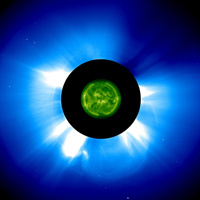 |
| ©SOHO |
| SOHO |
Kreutz-group comets, or sungrazing comets have been observed for
many hundreds of years. They travel very close to the Sun (if they were
to hit it, they would become 'sunstrikers'), with perihelion distance
less than 0.01 Astronomical Units (the mean distance between the Earth
and the Sun), or some 1460000 km.
When it comes to comet catching, the SOlar and Heliospheric
Observatory has one big advantage over everybody else: its location.
Situated between the Sun and Earth, it has a privileged view of a
region of space that can rarely be seen from Earth. From the surface,
we can see regions close to the Sun clearly only during an eclipse.
Roughly 85% of SOHO discoveries are fragments from a once-great
comet that split apart in a death plunge around the Sun, probably many
centuries ago. The fragments are known as the Kreutz group and now pass
within 1.5 million km of the Sun's surface when they return from deep
space.
At this proximity, which is a near miss in celestial terms, most of
the fragments are finally destroyed, evaporated by the Sun's fearsome
radiation - within sight of SOHO's electronic eyes. The images are
captured by the Large Angle and Spectrometric Coronograph (LASCO), one
of 12 instruments on board.
Of course, LASCO itself does not make the detections; that task
falls to an open group of highly-skilled volunteers who scan the data
as soon as it is downloaded to Earth. Once SOHO transmits to Earth, the
data can be on the Internet and ready for analysis within 15 minutes.
Enthusiasts from all over the world look at each individual image
for a tiny moving speck that could be a comet. When someone believes
they have found one, they submit their results to Karl Battams at the
Naval Research Laboratory, Washington DC, who checks all of SOHO's
findings before submitting them to the Minor Planet Center, where the
comet is catalogued and its orbit calculated.
The wealth of comet information has value beyond mere
classification. "This is allowing us to see how comets die," says
Battams. When a comet constantly circles the Sun, it loses a little
more ice each time, until it eventually falls to pieces, leaving a long
trail of fragments. Thanks to SOHO, astronomers now have a plethora of
images showing this process. "It's a unique data set and could not have
been achieved in any other way," says Battams.
All this is on top of the extraordinary revelations that SOHO has
provided over the 13 years it has been in space, observing the Sun and
the near-Sun environment. "Catching the enormous total of comets has
been an unplanned bonus," says Bernhard Fleck, ESA SOHO Project
Scientist.
Australia: Fireball at Ayers Rock
Astronomy Picture of the Day
Sat, 28 Jun 2008 12:06 EDT
A weekend trip for astrophotography in central Australia can result in gorgeous skyscapes. In this example recorded in March of 2006, the center of our Milky Way Galaxy rises over planet Earth's horizon and the large sandstone formation called Uluru, also known as Ayers Rock.
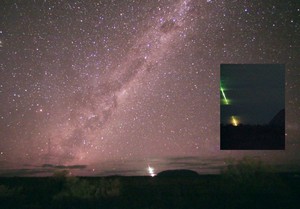 |
| ©Joseph Brimacombe |
| Fireball at Ayers Rock |
After setting up two cameras to automatically image this celestial
scene in a series of exposures, one through a wide-angle and the other
through a telephoto lens, photographer Joseph Brimacombe briefly turned
his back to set up other equipment.
To his surprise, the ground around him suddenly lit up with the brilliant flash of a fireball meteor. To his delight, both cameras captured the bright meteor streak. Highlighted in the telephoto view (inset), the fireball trail shines through cloud banks, just left of Ayers Rock.
Crater study surprise: Deep in ground where meteorite hit, rocks are full of extra-salty water
Dennis O'Brien
Baltimore Sun
Fri, 27 Jun 2008 12:55 EDT
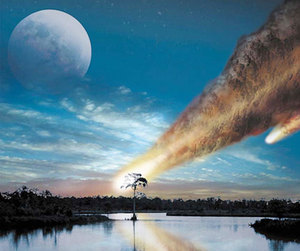 |
| ©Handout out photo by Science |
| An artist's conception of the mile-wide meteorite crashing into Earth 35 million years ago in the Chesapeake Bay. |
Scientists drilling into the site where a giant meteorite smashed
into the lower Chesapeake Bay millions of years ago have found one more
surprise amid the microscopic life and pockets of prehistoric ocean.
The water is saltier than expected - and no one is sure why.
"It's not a reservoir. It's water in pores and in cracks and
shattered rocks," said Ward Sanford, a hydrologist with the U.S.
Geological Survey.
Scientists have been examining the bay impact crater since its discovery in 1993.
Today, they published in the journal Science the report on core samples extracted from this mile-long shaft - the deepest so far.
The analysis sheds light on how the meteorite that struck Earth 35
million years ago created habitats conducive to microscopic life,
according Greg Gohn, a researcher at the U.S. Geological Survey and the
report's lead author.
"We're looking at all of the effects of these impacts," he said.
Water as salty as that which researchers found at the drill site has
been extracted from sites in Maryland and North Carolina over the
years, but it was from much lower depths in those locations, Sanford
said.
At the crater site, the impact may have brought briny water closer to the surface, he said.
After the meteorite hit, subterranean water, rock and sediment rose
up and then settled into cavities like cereal poured back into a box,
Sanford said.
It could be that salty water from deep inside the planet rose up as the debris resettled, he said.
Tests on salinity of the water show it is twice as salty as sea
water but poses no immediate danger to the groundwater supplies of
nearby Newport News and other Virginia Tidewater communities, the
researchers say. The sediments are too thick to let it pass, Sanford
said.
"It takes a long time for the saltwater to move that far. And water doesn't flow through those sediments that easily," he said.
The effort to study the Chesapeake Bay impact crater is a work in
progress. An international team of 40 scientists will continue testing
the shattered rocks, sediment and microbes in core samples extracted on
a privately owned farm five miles north of Cape Charles, Va., between
July and December 2005.
But so far, scientists say evidence in the shattered and superheated
rocks and sediments shows that when the mile-wide meteorite splashed
into the underwater coastal plain, it created a tsunami that threw
vapors into space, incinerated everything in its path and sent
shattered rocky material flying for thousands of miles.
"It would've been a huge splash," said David A. Kring, a
Houston-based crater expert at the Lunar and Planetary Institute, who
reviewed the report but was not a part of the study.
The bay crater is the largest in the United States and by some estimates the sixth-largest in the world.
The meteorite that formed it helped shape the bay, continues to
affect water supplies in surrounding Virginia communities and is used
by teachers in Maryland and elsewhere to spark interest in geology.
"It's very exciting stuff," said Rachel Burks, a geology professor who lectures on the crater to students at Towson University.
The $1.5 million drilling project confirmed that the meteorite's
impact created a "sterilizing pulse" that wiped out most of the
microbial life at depths below 2,600 feet, said Mary Voytek, a USGS
biologist.
Nutrients created by animals and plants wiped out by the blast were
washed down into a cavity formed by the impact. Shock waves from the
impact created pore-filled rock and sediments, Voytek said. The result:
nooks and crannies at depths below 4,600 feet that harbor more
mysterious microscopic organisms than anyone expected.
"What happened is, you've created a nice little incubator for life," she said.
The researchers had planned to drill 7,200 feet. But a huge granite
slab, dislodged by the impact 35 million years ago, limited their
progress to a little over a mile, roughly 1,400 feet short of the goal.
"Ideally we would've wanted to go deeper, and if we hadn't had to slow down, we would have," Gohn said.
Nutrients created by animals and plants wiped out by the blast were
washed down into a cavity formed by the impact. Shock waves from the
impact created pore-filled rock and sediments, Voytek said. The result:
nooks and crannies at depths below 4,600 feet that harbor more
mysterious microscopic organisms than anyone expected.
"What happened is, you've created a nice little incubator for life," she said.
The researchers had planned to drill 7,200 feet. But a huge granite
slab, dislodged by the impact 35 million years ago, limited their
progress to a little over a mile, roughly 1,400 feet short of the goal.
"Ideally we would've wanted to go deeper, and if we hadn't had to slow down, we would have," Gohn said.
Researchers say impact craters can reveal clues about prehistoric
conditions that spawned some of the earliest forms of life on Earth.
Drilling can shed light on the size of the meteorite, how hard it
struck and what it did to the planet, scientists say.
"What is the consequence of a meteor impact? Does it sterilize the
crater area and, if it sterilizes things, how quickly do microorganisms
repopulate the crater fill material?" said David Vanko, a geology
professor at Towson University.
Vanko, who helped collect and classify core samples, plans to
publish findings next year on the heat and geothermal energy from the
impact, based on analyses of melted and crystalline rocks.
Prehistoric Earth was probably pelted by millions of meteorites,
said Kring, of the Lunar and Planetary Institute. He oversaw drilling
in 2001 into the Yucatan peninsula crater, where scientists believe a
meteorite struck 65 million years ago, leading to dinosaurs' extinction
For corroboration, he and others look to the moon, where evidence of up to 400,000 impacts is visible on the surface.
But researchers have discovered only 170 craters on Earth because
the planet's surface is continuously being churned up by plate
tectonics, erosion and other geologic and climatic conditions, Kring
said.
Scientists spent 2 months drilling into the Yucatan crater - and then spent six years studying the core material, he said.
Tunguska Event: No answers to fireball mystery
David Hill
Otago Daily Times
Sat, 28 Jun 2008 12:12 EDT
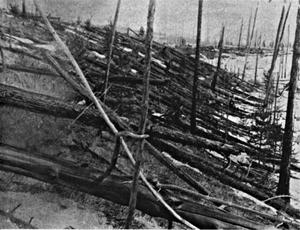 |
| ©Unknown |
| When Russian mineralogist Leonid Kulik made his way to the remote Tunguska River basin, his group found thousands of pine trees lying burned in a radial pattern. |
JUNE 30, 1908.
Reindeer graze beside the Podkamennaya or Lower Stony Tunguska River that winds through the Siberian steppes.
The tents of a few herdsmen stand nearby, but hardly anyone else lives in this land of swamps and forests.
7.14 am. Pine trees glow in the summer light. The morning is blue and cloudless.
Then a blinding ball of light rips across the sky, trailing a column of fire.
Some eye-witnesses say the light was red. Others claim it was blue, and cylindrical in shape.
It races down towards the Tunguska River, and explodes.
A spear of fire splits the sky. Explosions boom across the land.
A dark mushroom cloud begins rolling upwards. It will reach a height of 80km: ten times higher than Mt Everest.
Over 70km away, a farmer is in his yard when the sky to the north bursts into fire.
A wall of heat strikes him; his shirt is almost burned off. A blast
of air hurls him across the yard, and noise bellows all around.
House windows shatter; the building rocks.
Nearly 200km from the explosion, another farmer in a field hears several deafening bangs.
The pine forest thrashes. He and his horse are almost knocked off their feet. Soil flies into the air.
A wall of water is blown up the nearby river.
Elsewhere, herdsmen's tents are whipped from the ground by shock waves.
Only two people die, but near the explosion site, thousands of reindeer are burned to death.
A fireball brighter than the Sun can be seen from 1000km distant.
In France and Belgium, sunsets and sunrises are brilliant red for a week.
At night, clouds glow greeny-white, so bright that people can read a
newspaper at 3am. So what caused what's now cautiously labelled The
Tunguska Event?
A century later, the arguments continue.
In the years following 1908, Russia was torn by World War 1 and revolutions.
It wasn't till 1921 that Russian mineralogist Leonid Kulik made his
way to the remote Tunguska River basin on a survey for the Soviet
Academy of Sciences.
For two months, his group struggled through forests and across swamps, tormented by mosquitoes.
They reached a high plain, and gaped. Thousands of pine trees lay burned in a radial pattern.
At the centre, where the explosion seemed to have occurred, the ground was covered with swamps and scummy ponds.
Kulik urged the Government to send a bigger expedition to the area,
to search for iron from what he felt sure was a meteorite impact.
In 1927, the requested party arrived at what seemed to be Ground Zero, puzzled by the absence of a crater.
They drilled into the swampy ground and found nothing. Nothing except mud, dead wood, and tiny blobs of melted rock.
In the decades since, scores of scientific and less-scientific missions have headed to Tunguska.
According to Surendra Verma in The Tunguska Fireball, the consensus
of opinion now holds that the explosion of June 30, 1908 was caused by
an asteroid or comet (a fragment from short-term Comet Encke, say some).
The object exploded 5km-10km above the ground with a force estimated
at 10-15 megatonnes, a thousand times the force of the bomb dropped on
Hiroshima. A 1938 aerial photographic survey estimated that some 80
million trees had been felled over a 2000sqkm area.
In the 1960s, Soviet nuclear airburst tests produced the same
pattern of pines directly below the explosion still standing but with
branches stripped off, while others more distant lay pointing away from
the blast.
So, an aerial blast.
Comet or asteroid? Eye-witnesses described the fireball entering Earth's atmosphere on a shallow trajectory.
An ice-and-rubble comet should have disintegrated almost
immediately, whereas the Tunguska object apparently remained intact
till just above the surface.
On the other hand, those bright nights following the explosion fit
the scenario of a trail of comet dust dispersed through the upper
atmosphere.
If the object exploded just a few kilometres above the surface, the downward blast should have formed a crater.
Nobody has ever found a crater at Tunguska.
Then in 1999, an Italian expedition to Lake Cheko, 8km northwest of
the explosion site, suggested that the lake's bowl-shaped crater was
just the right shape for such an explosion.
Moreover, their instruments seemed to show a massive object buried beneath the lakebed.
And Lake Cheko doesn't appear on any maps before 1929. Promising but inconclusive. No underground object has been found.
Dissenting voices argue that the lake doesn't fit the classic crater shape at all.
Plus nearby, century-old trees don't stand the way they should beneath a blast site.
But should there actually be a crater? Computer simulations suggest
that a stony body 60m across - the right size for such an explosion -
would build up such pressure and temperature as it bored through the
atmosphere that it might blow itself apart, leaving no crater but
causing blast and thermal damage over a wide area.
Others have suggested more lurid causes for the fireball, flash and explosion.
Did a microscopic black hole, the sort formed in the first seconds
of the universe, speed through our planet, entering at Tunguska?
Problem: where's the exit hole? Did a speck of anti-matter hit
Earth? Problem: no sign of nearby gamma-ray bursts, which would be the
signature of such an event.
Was it a ball of lightning? A blob of white-hot gas hurled from the
Sun? A doomed alien spaceship? A laser ray from a distant planet?
Enter Tunguska Conspiracy on the web, and you'll see these are among the more restrained suggestions.
Another theory suggests the explosion wasn't caused by something from above, but by something from below.
Underneath the Tunguska area lie big deposits of oil and natural gas.
Did gas seep upwards through a crack in the ground and then explode
in the great fireball? Such gas would probably include methane, which
burns very easily.
The gas might keep burning for several days, which would explain the
bright clouds that people kept seeing at night after the explosion.
But this theory doesn't explain the blazing object that so many people saw hurtling down the sky.
The Tunguska Event isn't the only one of its kind.
In the past 100 years, nearly 20 aerial explosions of apparently
extraterrestrial origin have been reported, the most recent occurring
high above the Mediterranean in June 2002.
But the largest of these others, over the Amazonas region of Brazil
during August 1930, was estimated at about 500,000 kilotonnes.
The Tunguska explosion was 25 times more powerful.
Not suprisingly, it has given further weight to demands for the development of an asteroid deflection system.
Picture the Tunguska Event happening now over New York or London.
Actually, don't.
Blast but "no bomb" in Pakistani cities
Augustine Anthony
Reuters
Mon, 30 Jun 2008 03:09 EDT
A loud blast alarmed residents and security officials in the
Pakistani capital, Islamabad, and nearby city of Rawalpindi on Monday
but police later said it appeared it had been a sonic boom.
Residents of both cities heard a big blast just before 11a.m. (6 a.m. British time).
"We have checked everywhere in Rawalpindi, all the main areas and
hospitals, but there is nothing," a senior city police official said
about 45 minutes after the blast was heard.
"It could have been a sonic boom but we are still investigating."
A Pakistani air force spokesmen said none of their aircraft had been over the city at the time of the blast.
A military official said there had been no bomb at any of the main
military installations in Rawalpindi, the headquarters of the Pakistani
army and the home of President Pervez Musharraf.
Militants have launched several bomb attacks in both Rawalpindi and Islamabad over the past year.
The Taliban militant commander held responsible for most of the
attacks threatened on the weekend to retaliate for a government
offensive against militants in a northwestern region on the Afghan
border.
Acid rain traces support meteor theory for 1908 Tunguska blast
RIA Novosti
Mon, 30 Jun 2008 14:35 EDT
International researchers investigating the Tunguska Event, an
explosion exactly 100 years ago in central Siberia, say acid rain
traces in the region back up the theory that the blast was caused by a
meteorite.
On June 30, 1908, an explosion equivalent to between 5 and 30
megatons of TNT occurred approximately 7-10 km (3-6 miles) above the
Podkamennaya Tunguska River in a remote Siberian region.
"Extremely high temperatures occurred as the meteorite entered the
atmosphere, during which the oxygen in the atmosphere reacted with
nitrogen causing a build up of nitrogen oxides," one of the authors of
the joint research, Natalia Kolesnikova, told RIA Novosti.
Kolesnikova said a similar impact 66 million years ago wiped out a
significant portion of life on Earth, including the dinosaurs.
The Tunguska blast flattened 80 million trees, destroying an area of
around 2,150 sq km (830 sq miles). However, despite the shockwaves
being detected as far away as the United Kingdom, the Tunguska Event
went largely unnoticed, eclipsed by global events leading up to WWI,
the Russian Revolution and subsequent civil war.
If the explosion had occurred some 4 hours and 47 minutes later, due
to the Earth's rotation it would have completely destroyed the then
Russian imperial capital of St. Petersburg.
It took almost 20 years, until 1927, before a research expedition
led by Leonid Kulik, a leading meteorite expert at the Academy of
Sciences, first managed to visit the remote Siberian region and see the
awesome destruction caused by the blast, and to take witness statements
from locals living in the area.
It was assumed that a huge meteorite had hit the area, although
Kulik failed, during his research in Siberia, to find an obvious crater.
In 1930, a British astronomer suggested the blast could have been
caused by a small comet, composed of ice and dust, which would have
been vaporized on impact with the Earth's atmosphere.
The research carried out by the Moscow State Lomonosov University,
Italy's Bologna University and Germany's Center for Environmental
Research in Leipzig backs up the most likely theory of a meteor
explosion.
However it is unlikely to put a stop to speculation on theories
ranging from alien attacks, UFOs, antimatter, doomsday events and black
holes.
Fire in the sky: Tunguska at 100
Paul Rincon
BBC
Mon, 30 Jun 2008 13:26 EDT
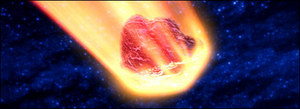 |
| ©Unknown |
| The Tunguska event was caused by a space rock tens of metres across |
At 7:17am on 30 June 1908, an immense explosion tore through the forest of central Siberia.
Some 80 million trees were flattened over an area of 2,000 square km (800 square miles) near the Tunguska River.
The blast was 1,000 times more powerful than the atomic bombs
dropped on Hiroshima and Nagasaki and generated a shock wave that
knocked people to the ground 60km from the epicentre.
The cause was an asteroid or comet just a few tens of metres across
which detonated 5-10km above the ground, 100 years ago today.
Eyewitnesses recalled a brilliant fireball resembling a "flying
star" ploughing across the cloudless June sky at an oblique angle.
The plume of hot dust trailing the fireball gave rise to
descriptions of a "pillar of fire", which was quickly replaced by a
giant cloud of black smoke rising over the horizon.
"The sky split in two and fire appeared high and wide over the
forest. The split in the sky grew larger, and the entire northern side
was covered with fire," one local remembered.
"At that moment I became so hot that I couldn't bear it, as if my
shirt was on fire... I wanted to tear off my shirt and throw it down,
but then the sky slammed shut. A strong thump sounded, and I was thrown
a few yards."
This eyewitness was lucky, but an elderly hunter who was much closer
to the explosion died after being flung against a tree by the blast.
That the airburst did not cause more casualties was in large part due
to the remoteness of the area.
Bright light
To many, this event - the biggest space impact of modern times -
serves as a reminder of the continuing threat posed to our planet by
objects from space.
If the Tunguska "impactor" had exploded over a major city such as London, the death toll would have been up in the millions.
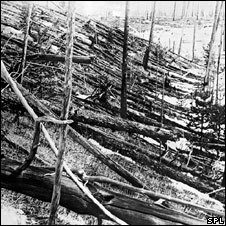 |
| ©SPL |
| Leonid Kulik found vast areas of forest had been levelled |
"Everything within the M25 would have been wiped out," Dr Mark
Bailey, director of the Armagh Observatory in Northern Ireland, told
BBC News.
The effects of Tunguska were not limited to Siberia. In London, it
was possible to read newspapers and play cricket outdoors at midnight.
This is now thought to have been due to sunlight scattered by dust from
the fireball's plume.
The Russian mineralogist Leonid Kulik visited the region in 1921,
interviewed local eyewitnesses and soon realised that a meteorite must
have been the cause.
He persuaded the Russian authorities to fund an expedition to the
region in 1927, during which he was able to explore the vast zones of
fallen trees.
 |
| ©Mark Bailey |
| The Churgin creek flows past the epicentre of the Tunguska impact |
An aerial survey was carried out in 1938, revealing how the
flattened trees were angled away from the epicentre of the explosion
over a 50km-wide zone which formed a butterfly shape.
Trees at the epicentre were charred and stripped of their branches
and bark, but were left standing, which would lead to them being coined
"telegraph poles".
Some researchers think a comet would have been too fragile to have
caused the Tunguska event, and that an asteroid is therefore the most
likely candidate.
But Mark Bailey thinks some comets could contain chunks of tough
material that could survive the plunge through Earth's atmosphere.
Meteor shower
Indeed, one theory proposes that the Tunguska object was a fragment
of Comet Encke. This ball of ice and dust is responsible for a meteor
shower called the Beta Taurids, which cascade into Earth's atmosphere
in late June and July - the time of the Tunguska event.
The absence of any crater connected with the Tunguska event has left
the door open for some outlandish alternatives to the meteorite theory.
A lump of anti-matter, a colliding black hole and - inevitably - an
exploding alien spaceship have all been proposed as the possible source
of the blast.
But in 2007, Giuseppe Longo, from the University of Bologna, Italy,
and his colleagues, suggested they might have found something Leonid
Kulik had missed all those years ago.
Lake Cheko does not appear on any maps of the area made before 1908;
it also happens to lie North-West-West of the epicentre, on the general
path taken by the impactor as it plummeted to Earth.
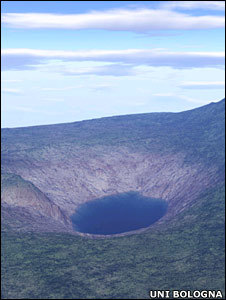 |
| ©Uni Bologna |
| Does Lake Cheko have anything to do with the Tunguska blast? |
To Dr Longo, a radar signal from beneath the lake is suggestive of a
dense object, possibly part of the Tunguska meteorite, buried about 10m
down. The team plans to conduct an expedition to the area in 2009, to
investigate this possibility.
"We have no positive proof it is an impact crater, we have come to
this conclusion [about Lake Cheko] through the negation of other
hypotheses," Dr Longo told BBC News last year.
But other researchers, including Gareth Collins and Phil Bland of
Imperial College London, cast doubt on the idea Lake Cheko has anything
to do with the Tunguska event.
They point to trees older than 100 years which are still standing
around the rim of the lake (and, they say, should have been levelled by
the impact) and the features of the lake itself, which, the researchers
argue, are inconsistent with an impact origin.
Rock search
One hundred years on, the Tunguska event remains a vibrant area for
study, especially in Russia. Last week, researchers gathered in Moscow
for a scientific conference arranged to coincide with the anniversary.
Topics on the agenda were the continuing search for pieces of the
space rock, the comet vs asteroid debate and the relationship of the
event to the Beta Taurid meteor shower.
Dr Longo and colleagues presented a new tree-fall map, which they
say is suggestive of two separate objects exploding in the atmosphere
over Tunguska on 30 June.
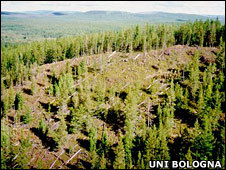 |
| ©Uni Bologna |
| Felled trees can still be seen today at the Tunguska site |
The conference also heard presentations on other historic and
prehistoric cosmic impacts and current strategies for tackling an
asteroid headed for Earth.
An asteroid on the order of one kilometre in diameter hits the Earth roughly once every 100,000 years.
Space rocks about 10m across - roughly the size of the Tunguska
object - are thought to hit our planet about once every 3,000 years.
But Mark Bailey suspects they might be more frequent than that. He
has investigated another event in 1930 known as the "Brazilian
Tunguska".
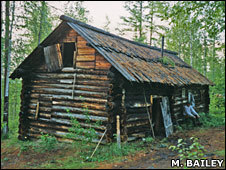 |
| ©Mark Bailey |
| Kulik used this hut on his expeditions in the first half of the 20th Century |
This little-known event was apparently caused by three large
meteorites in the upper reaches of the Amazon. The fires it caused
continued uninterrupted for weeks and depopulated hundreds of
kilometres of jungle.
And in June 2002, US military satellites detected an explosion in
the Earth's atmosphere with the energy of 12 kilotonnes of explosive.
The event has been attributed to an asteroid which remained undetected
as it approached our planet and plummeted through the atmosphere.
'Nuclear winter'
The international Spaceguard survey programme has been working to
identify the Near-Earth Objects larger than 1km - the class of object
could cause a "nuclear winter" if one were to strike the planet,
possibly threatening civilisation.
Objects the size of the one that caused the Tunguska impact are too small to be seen by present-day surveys.
But there is no guarantee the next object will explode over the sea
or a sparsely populated wilderness. This begs an obvious question: how
prepared are we for the next one?
Dr Richard Crowther is head of the United Nations Near Earth Object
(Neo) programme. He told the BBC News website: "Tunguska reminds us
that these impact events have occurred in the relatively recent past.
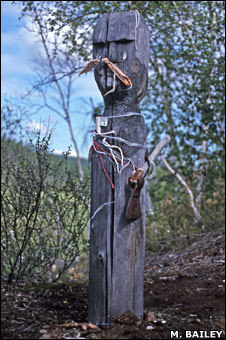 |
| ©Mark Bailey |
| A totem to local thunder god Agby stands at the Tunguska epicentre |
"The surveys suggest that objects of this size are numerous enough to anticipate similar events in the relatively near future."
Many observers are concerned by what they regard as a lack of action to counter the threat posed by near-Earth asteroids.
California-based space advocacy group the Planetary Society recently
awarded an Atlanta-based aerospace company $50,000 (£25,000) to design
a spacecraft which could rendezvous with and track the path of the
asteroid 99942 Apophis.
In 2029, this 270m-wide chunk of cosmic debris will closely approach
the Earth - so close, in fact, it will be visible with the naked eye.
If this primordial behemoth passes through a precise region in
space, or "keyhole", several hundred kilometres wide during this pass,
it will strike Earth in 2036.
The Planetary Society initiated its tagging mission because, it
says, Earth-based observations might not be sufficient to rule out an
impact in 2036.
There are several technologies that could be used currently to
tackle an asteroid heading on a collision course with Earth. One
proposal is to use nuclear weapons to completely vapourise the object.
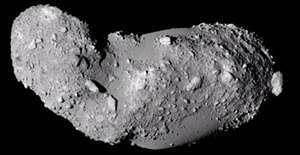 |
| ©Unknown |
| Asteroids larger than 1km have the potential to end civilisation on Earth |
Another is to use a spacecraft to "push" the asteroid off course.
This would involve a craft either slowing down or speeding up the
object to ensure that it misses its appointment with the Earth's
surface.
If, for some reason, the asteroid is not spotted in time, or the
deflection mission arrives at its target too late, it might be
necessary to nudge the space rock just enough so that it strikes the
ocean, or a remote, thinly populated area on Earth.
Dr Crowther, who is based at the UK's Science and Technology
Facilities Council (STFC), comments that Neos "do not recognise
national boundaries".
For this reason among others, he said, it was important that any
policy framework established to counter the asteroid threat "should
encourage nations to work together to share data, expertise and
resources to assess and mitigate the risk of a future impact".
Dot Earth: Apocalypse Then. Next One, When?
Andrew C. Revkin
New York Times
Mon, 30 Jun 2008 12:35 EDT
Monday marks the 100th anniversary of the moment when something
roared through the empty skies over Siberia and exploded, blasting
forests for hundreds of square miles. More such incoming space rocks
are inevitable. Are we ready? No.
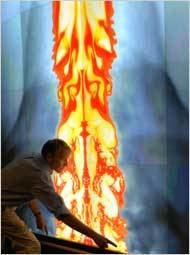 |
| ©Randy Montoya/Sandia |
| Sandia researcher Mark Boslough with an image from a simulated mid-air explosion of an asteroid. |
Last year, scientists at the Sandia National Laboratories in New Mexico did some simulations (here's one virtual Tunguska-like fireball) and proposed that the object, most likely an asteroid, could well have been just a few dozen yards across. That is distressing, disaster experts say, because near-earth objects this size are presumed to be much more common than larger space rocks, and they are too small to be easily spotted long in advance with the telescopes used to track such debris. (For more, New Scientist has a nice Tunguska overview.)
So while the odds are that the next Tunguska-size object will arrive
over the ocean or Earth's still-vast stretches of empty land, there's
no reason why it couldn't explode over Chicago or Taipei. The big
near-Earth objects, or NEO's, are being tracked fairly well, but quite
a few experts on space, risk, and resilience say we'd better start sifting for the small ones,
too. And then there's the matter of doing something about it, so the
endgame looks more like "Armageddon" than "Deep Impact." The world is
in the early stages of devising methods for deflecting asteroids. To
get a sense of what's out there, have a look, too, at this mesmerizing animated graphic showing just how much space rock is floating around (of the size astronomers are currently tracking, at least).
The graphic shows known flybys of large asteroids within 12 million
miles of Earth - the blue dot in the center - in 2002. The animation
was created by Gareth Williams of the Minor Planet Center at the
Smithsonian Astrophysical Observatory, under the auspices of the
International Astronomical Union). These are somewhat close calls by
Solar System standards and don't include objects anywhere near the
small size of whatever blew up over Siberia 100 years ago.
I asked Rusty Schweickart, an Apollo 9 astronaut who's become a
leading voice in the push for taking space rocks seriously, to weigh in
on the centennial of Tunguska, and he wrote a whimsical letter that
explains the risk and possible response by "someone" who took a little
action back in 1908. Click to have a look.
Rusty Schweickart of the B612 Foundation wrote this imagined letter to explain the situation:
Dear Sasha & Tatiana:
Well, 100 years have now passed and I finally feel comfortable in
letting you know that I really appreciate the sacrifice you made (or
your family that might have been made) when I slowed the Earth's
rotation momentarily back in late June 1908. That's not something I
normally do(!) but in that case I really felt I had to intervene.You see, what's now referred to as the Tunguska impactor, a
smallish asteroid about 40 meters in diameter, was headed for an impact
with Earth, directly over Moscow. It would have been a disaster of
truly huge proportions, and I just couldn't stomach that given what
Russia was going through at the time. So I slowed the Earth down for a
bit... just a few minutes per day for a few weeks. As a result the
asteroid hit way out in the middle of Siberia instead of directly over
Moscow.Now there are surely millions of present day Muscovites who owe
their lives to the sacrifice that your great-grandfather made in taking
the hit for them. In all likelihood he and your great-grandmother would
have had many more children than just your grandmother, but there he
was in the most desolate section of Siberia, tending his reindeer herd,
far, far from everyone else. I'm truly sorry that you don't have many
more cousins to celebrate the holidays with, but in the larger scheme
of things it seemed to be the right thing to do at the time.But I'm really tired of this kind of intervention; it just takes
too much out of old fate to pull of this kind of thing in the future.
Since so much has happened in the past 100 years in terms of technology
development, you and your fellows around the planet are really able to
handle this kind of thing yourselves. I mean, after all, your
telescopes are now finding the larger asteroids that make close passes
by Earth, and soon they'll be finding the smaller ones like the
Tunguska impactor. At least they could be doing that.And as you know shoving an asteroid slightly off its course is far
simpler (and cheaper) than going out to take pictures of yet another of
Saturn's moons!So I'm pretty content to let the celestial clockwork and human
ingenuity run their course undisturbed by pro-active fate. From my
perspective it seems that with all the tools required, both an early
warning capability and the ability to intervene to slightly alter an
asteroid's orbit, humanity ought to be able to get the job done without
me mucking about with space-time.So good luck. All it really takes is for you to convince your
fellow human beings that they really are all related and really can, by
coming to a simple agreement to act in concert, protect both themselves
and future human (and fellow creatures') generations by sharing the
risk of slightly shrinking or enlarging any threatening asteroid's
orbit so that it misses the Earth. Really, you can do this, provided
you can all get together. Yes, I know, that's a big challenge. But let
me tell you, it's a far smaller feat for you to slightly alter the
shape of the local universe than it is for me to slow down the rotation
of the Earth!Good luck.
Fate
In his testimony on hazardous asteroids before the House Science Committee last November, Mr. Schweickart, representing his B612 Foundation, included this closing line to lawmakers:
NEOs are part of nature. A NEO impact is a natural hazard in much
the same way as are hurricanes, tsunamis, floods, etc. NEO impacts are
deceptively infrequent, yet devastating at potentially unimaginable
levels. NEOs are however not our enemies. We do not need to "defend"
against NEOs, we need to protect ourselves from their occasional
impact, as we do with other natural hazards. Unlike other natural
hazards, however, NEO impacts can be predicted well ahead of time and
actually prevented from occurring. If we live up to our responsibility,
if we wisely use our amazing technology, and if we are mature enough,
as a nation and as a community of nations, there may never again be a
substantially damaging asteroid impact on the Earth. We have the
ability to make ourselves safe from cosmic extinction. If we cannot
manage to meet this challenge, we will, in my opinion, have failed to
meet our evolutionary responsibility.
A few years earlier, I'd met him at a conference in Boulder, Colo. Mr. Schweickart had just given testimony before a a Senate committee,
and told a depressing story about his conversations with staff members
shortly afterward. To a person, they said the lawmakers they worked for
were convinced of the threat and need to invest more in protection. And
to a person, he recalled, they apologized that new money was unlikely
because making the deflection of asteroids a priority might backfire in
reelection campaigns.
Last year in an earlier post on asteroid impacts,
Mr. Schweickart mused on an issue at the heart of Dot Earth - how
political systems, reflecting human nature, still seem to be having a
hard time integrating scientific understanding, uncertainties and all,
in ways that result in policies and investments that could blunt risks
while fostering prosperity.
That same dynamic (or lack of dynamics) is at the heart of the
climate-energy challenge, but also this one, and others. For instance,
political imperatives are prompting the rebuilding of sections of New
Orleans that coastal and ocean experts say are inevitably going to be
immersed.
In the end, that is why Dot Earth is not a climate blog, or an
environment blog. It is an exploration of how humans, on the road
toward a population of 9 billion, more or less, can limit losses from
"slow drips" and "hard knocks" of all kinds - from indoor air pollution
and diarrhea to asteroids and global warming.
Do we have the technical capacity to spot and divert the next Tunguska or a bigger cousin? Yes.
Are actions keeping pace with emerging understanding of this threat?
Mr. Schweickart says it's not even close.
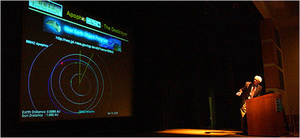
No comments:
Post a Comment